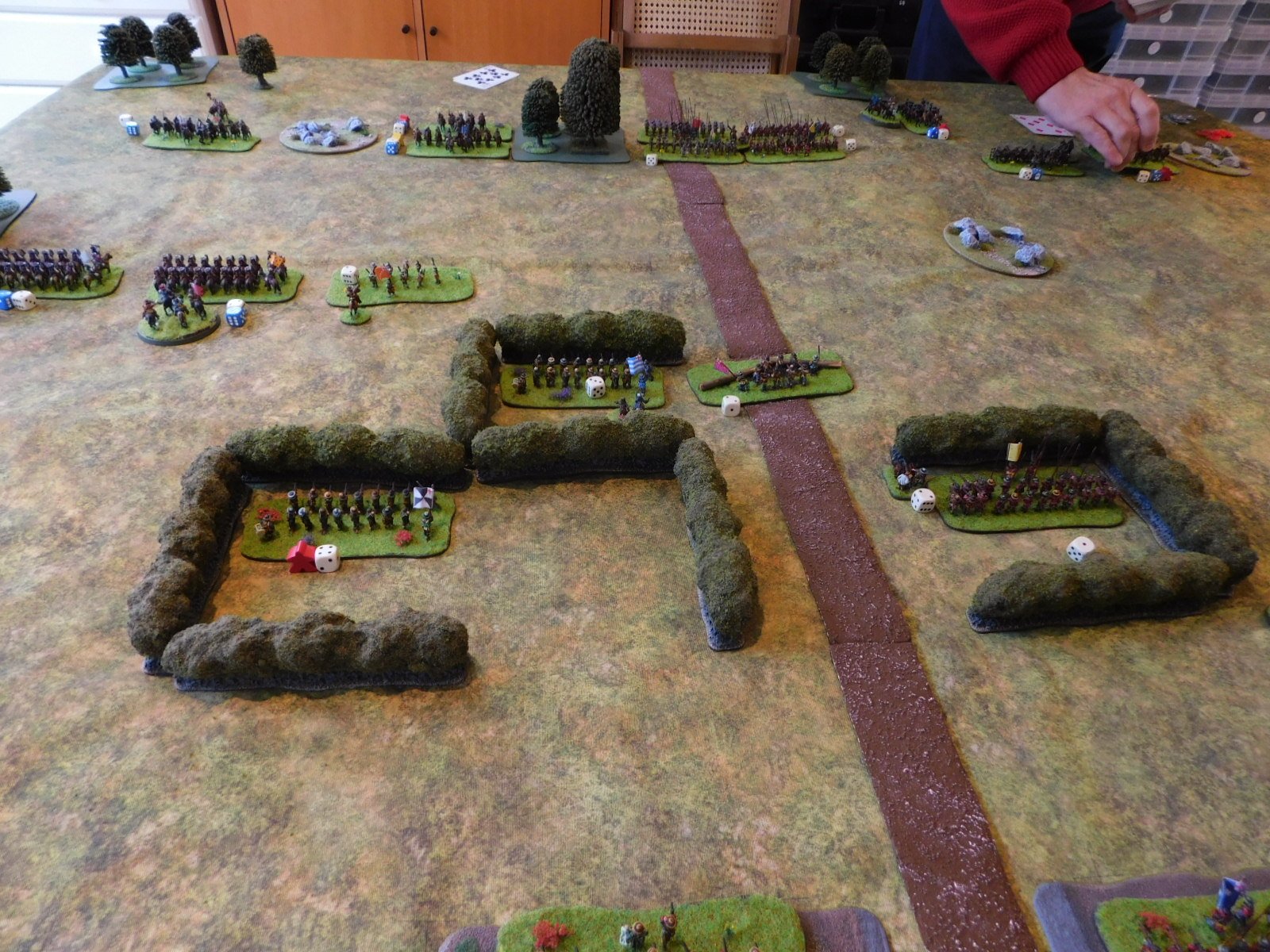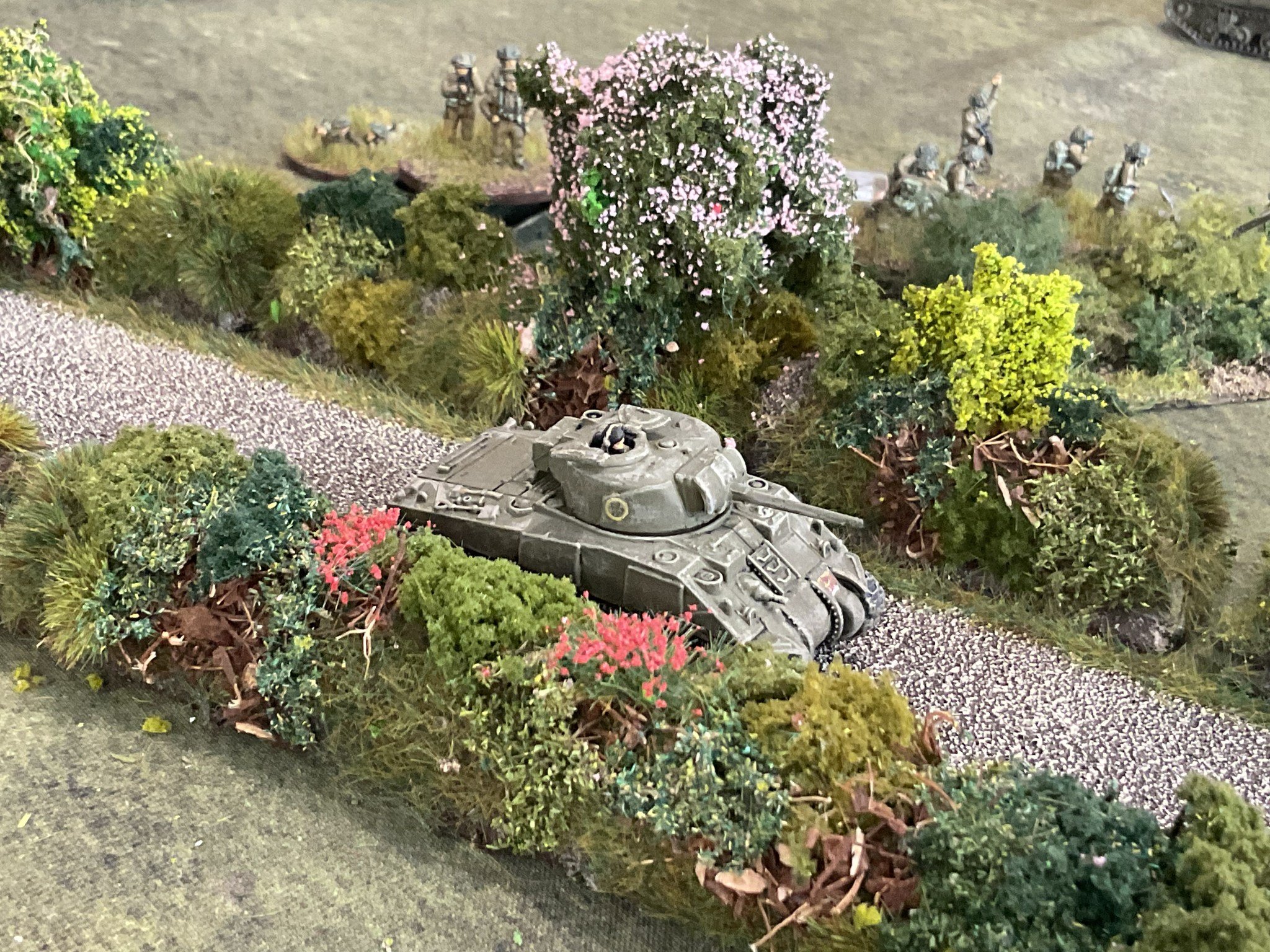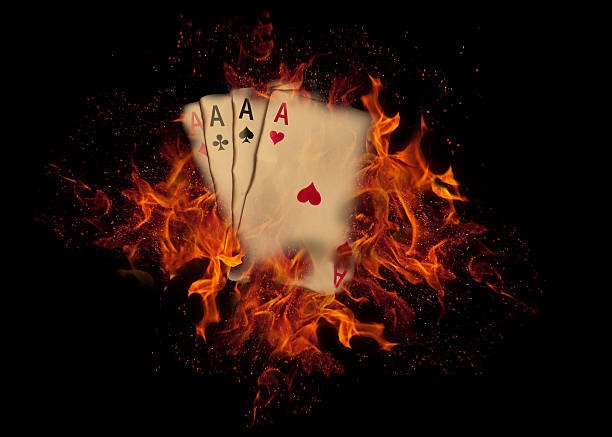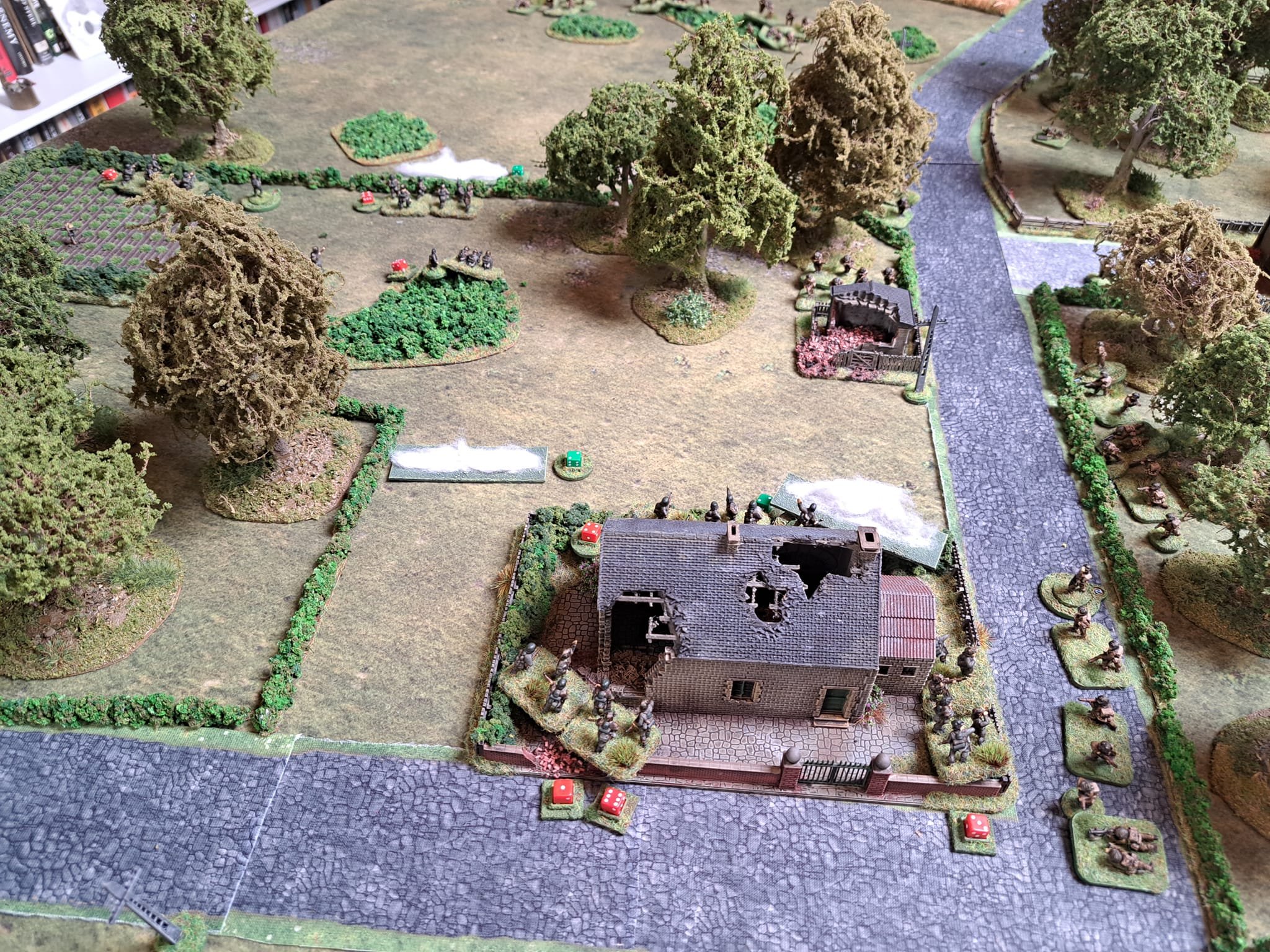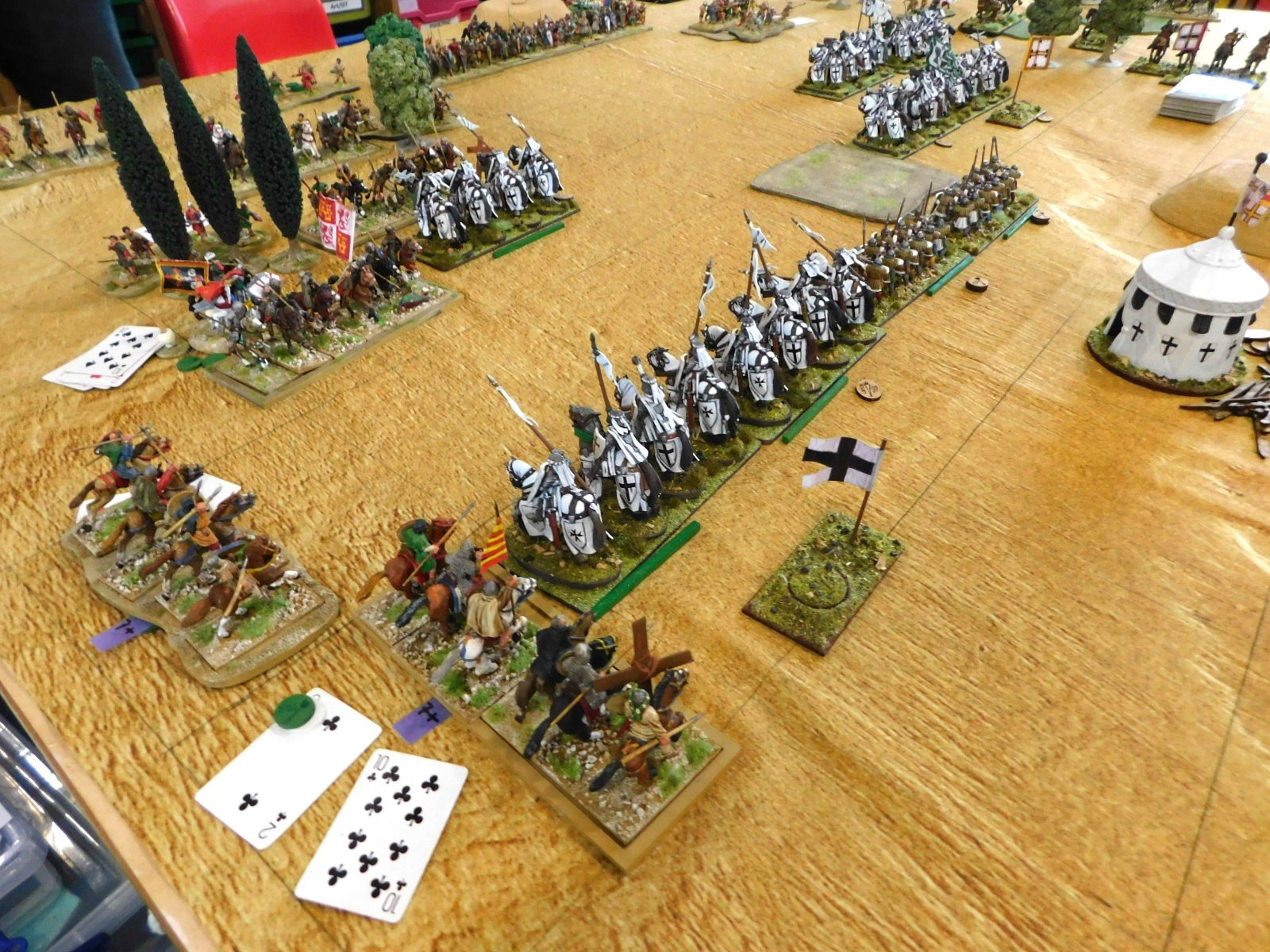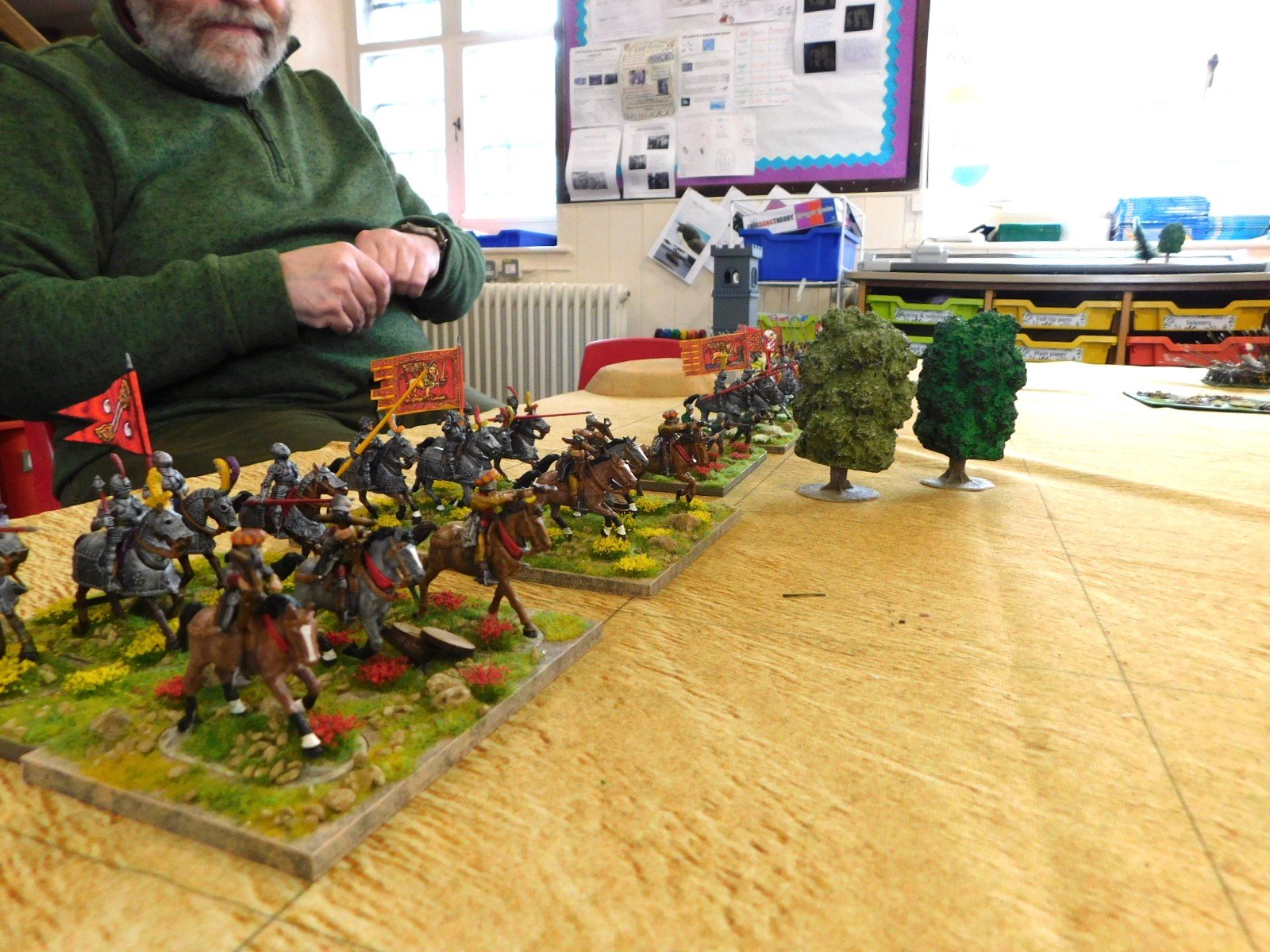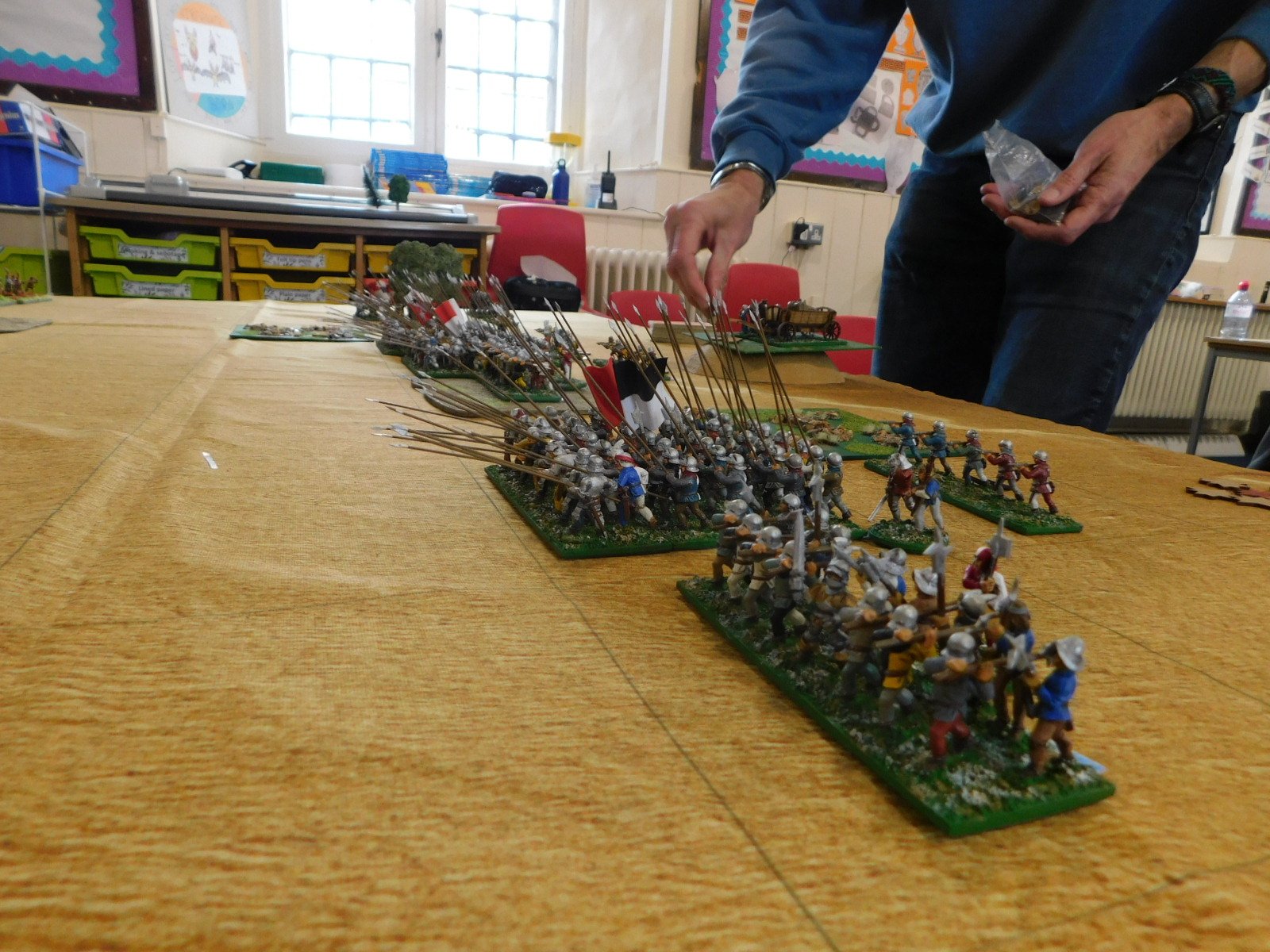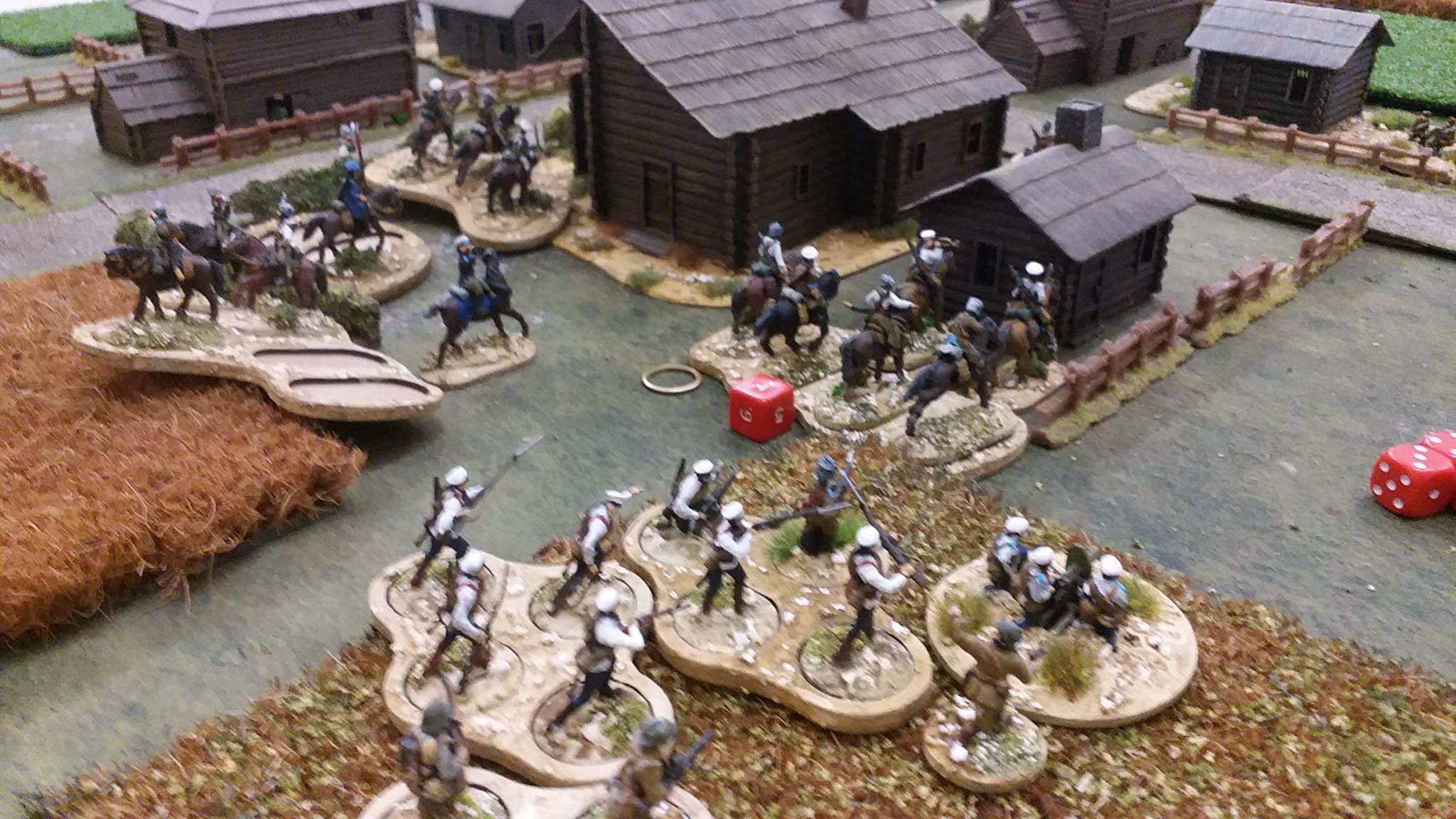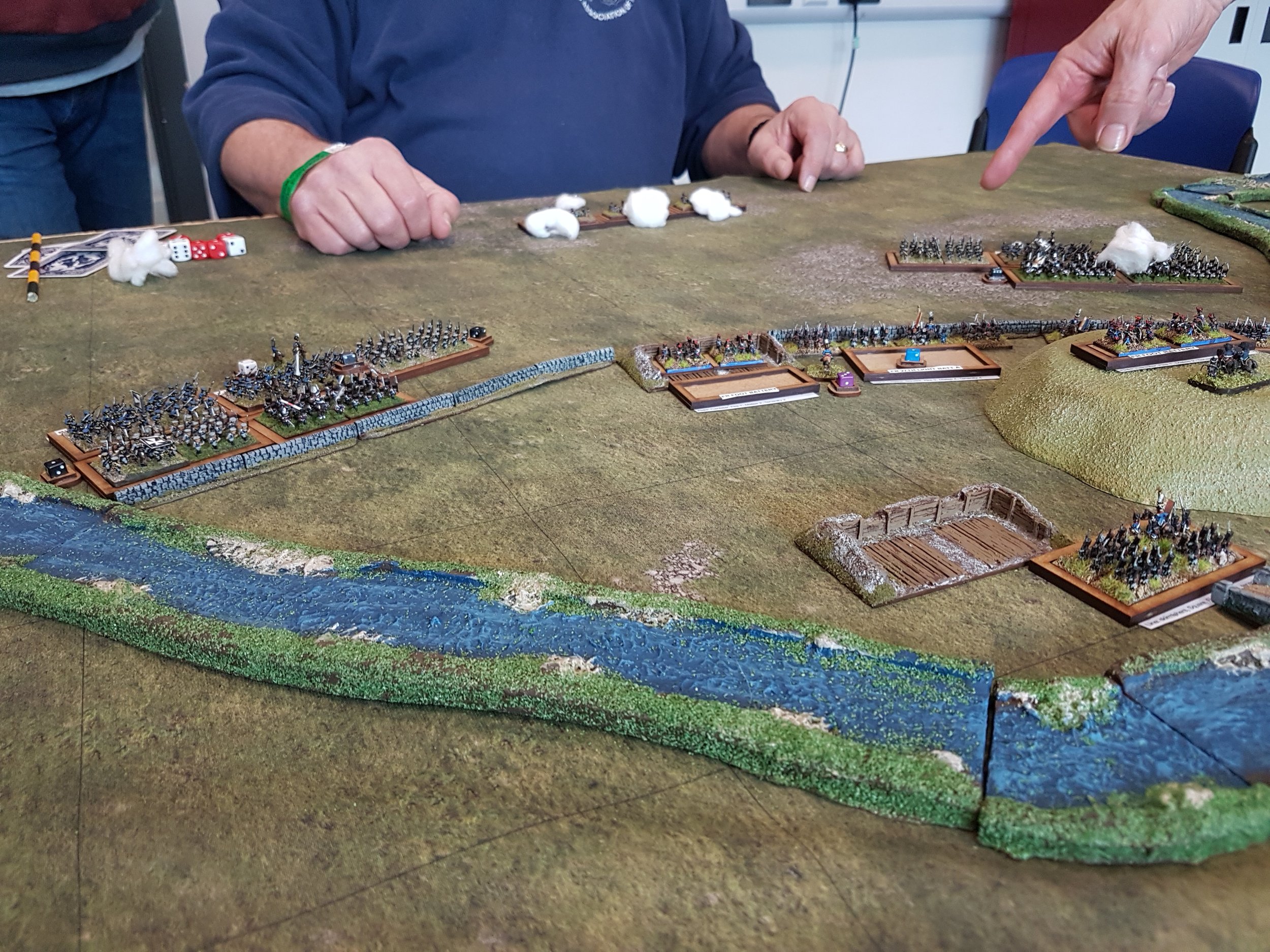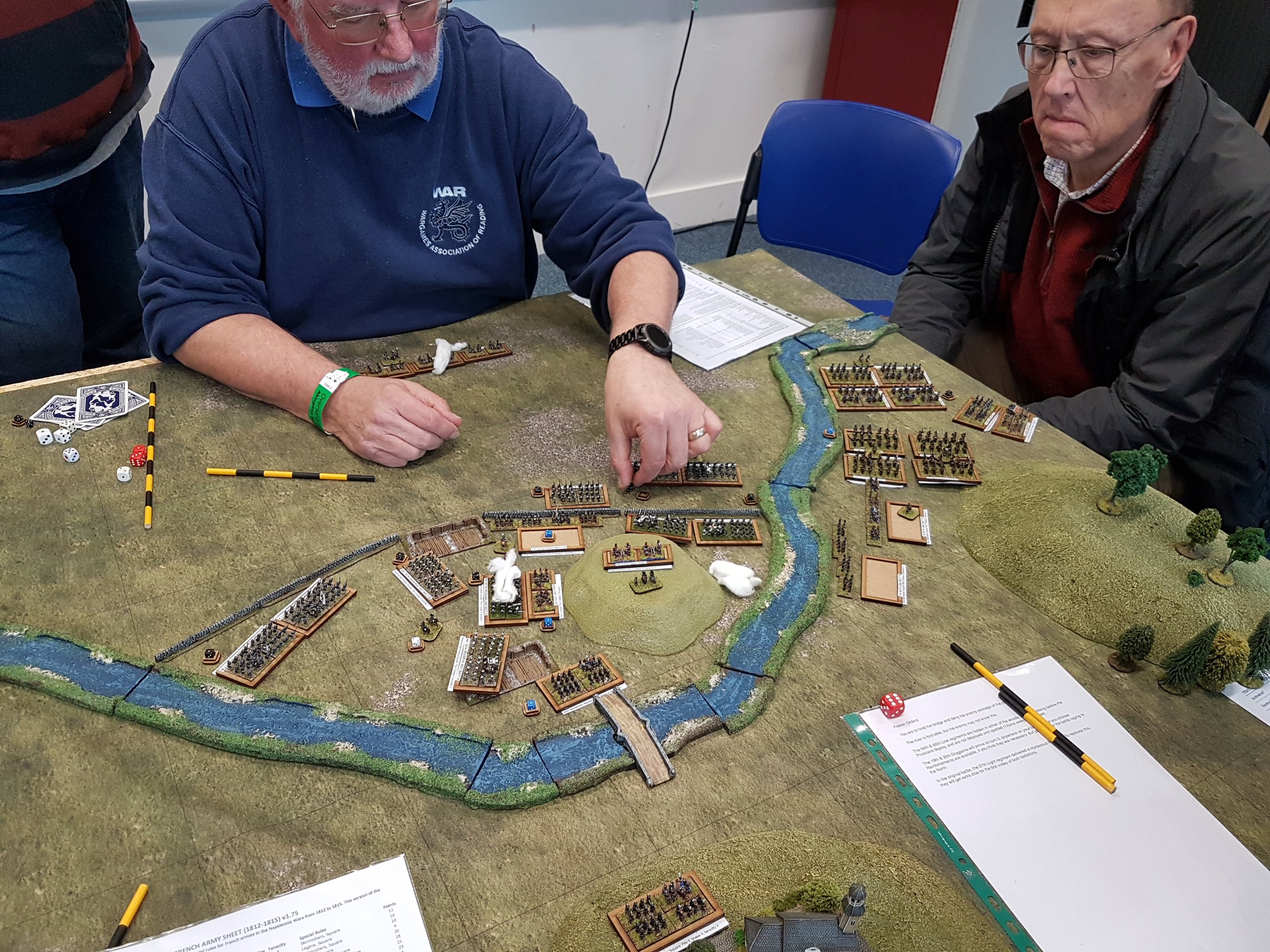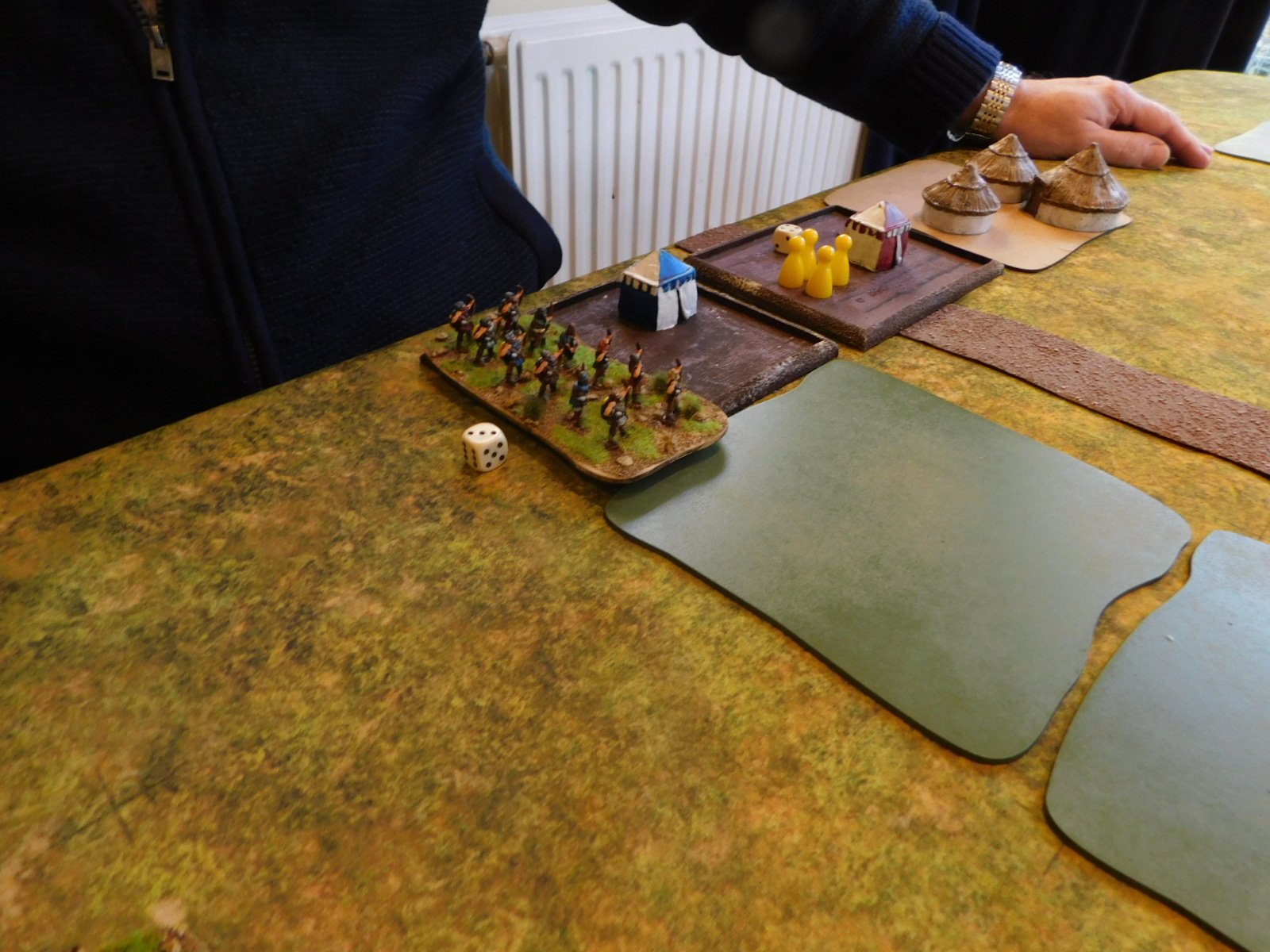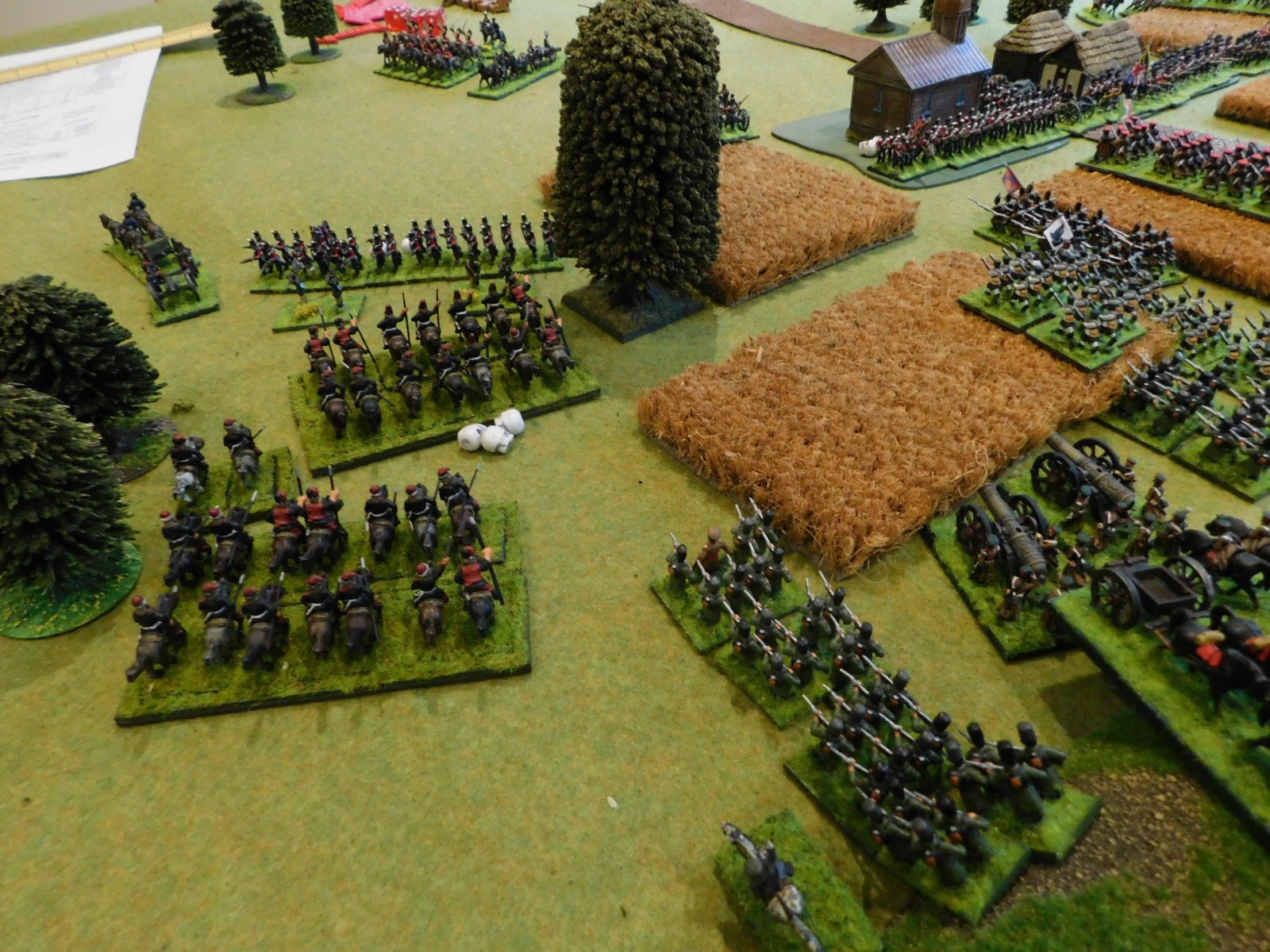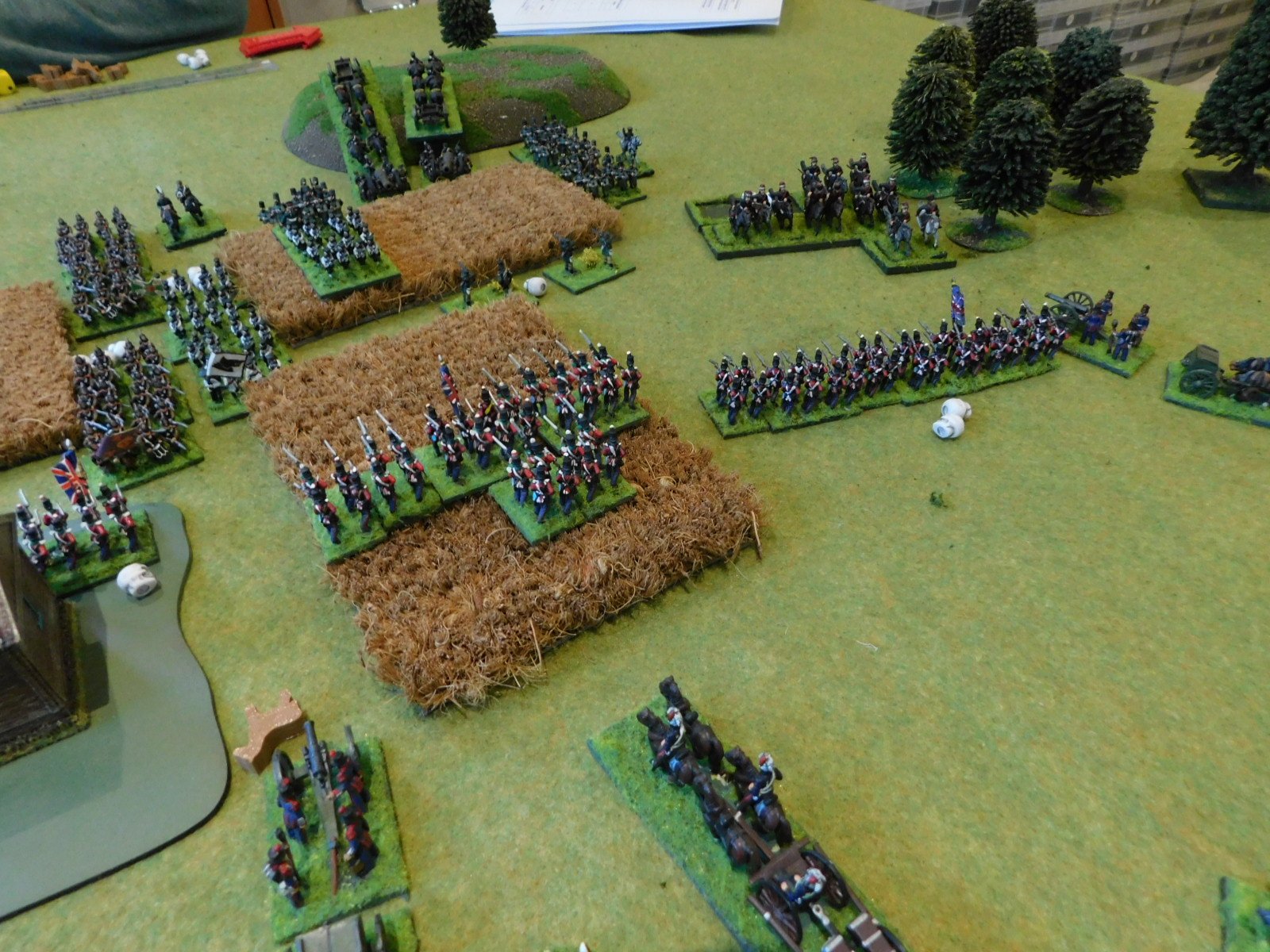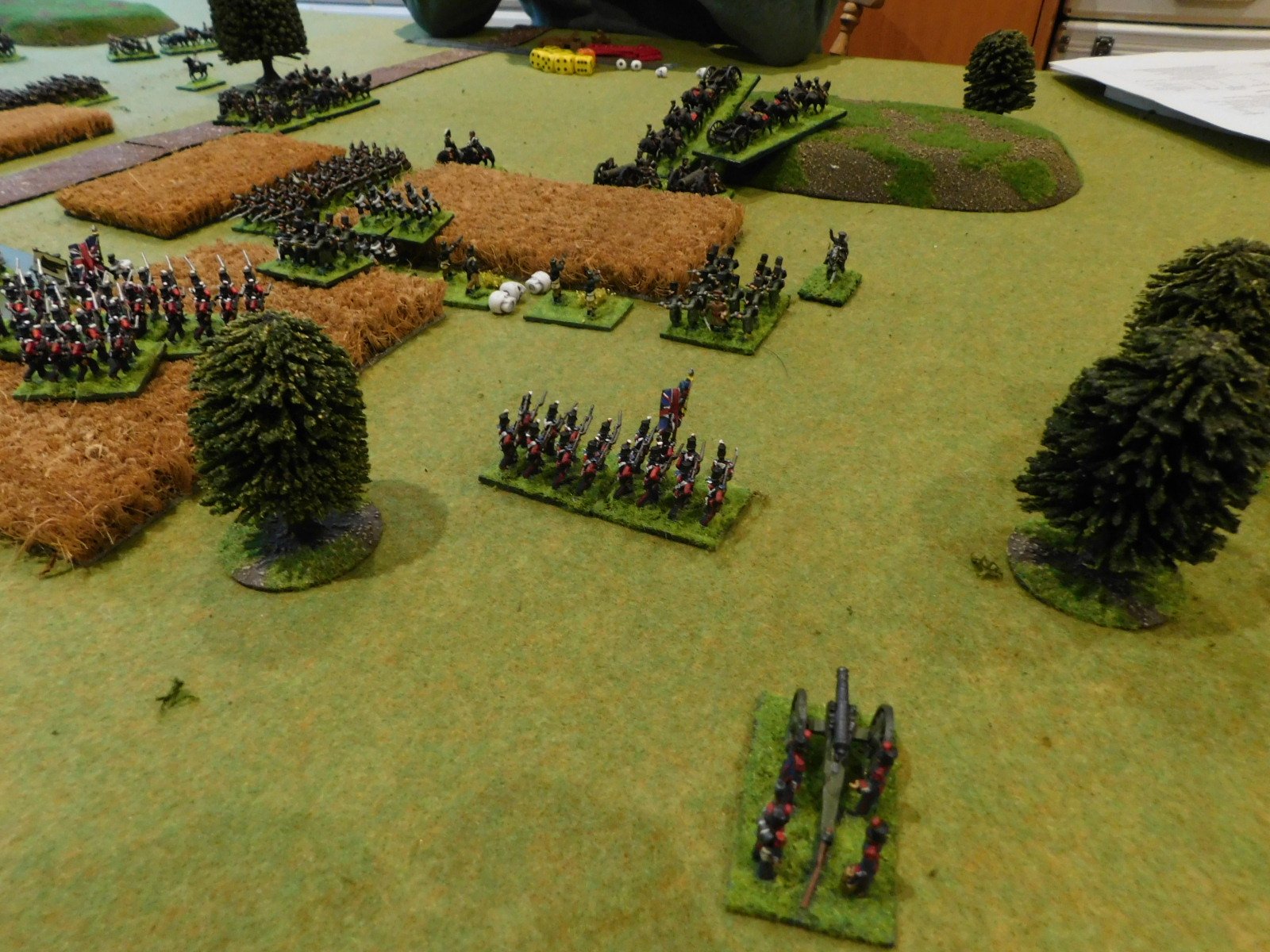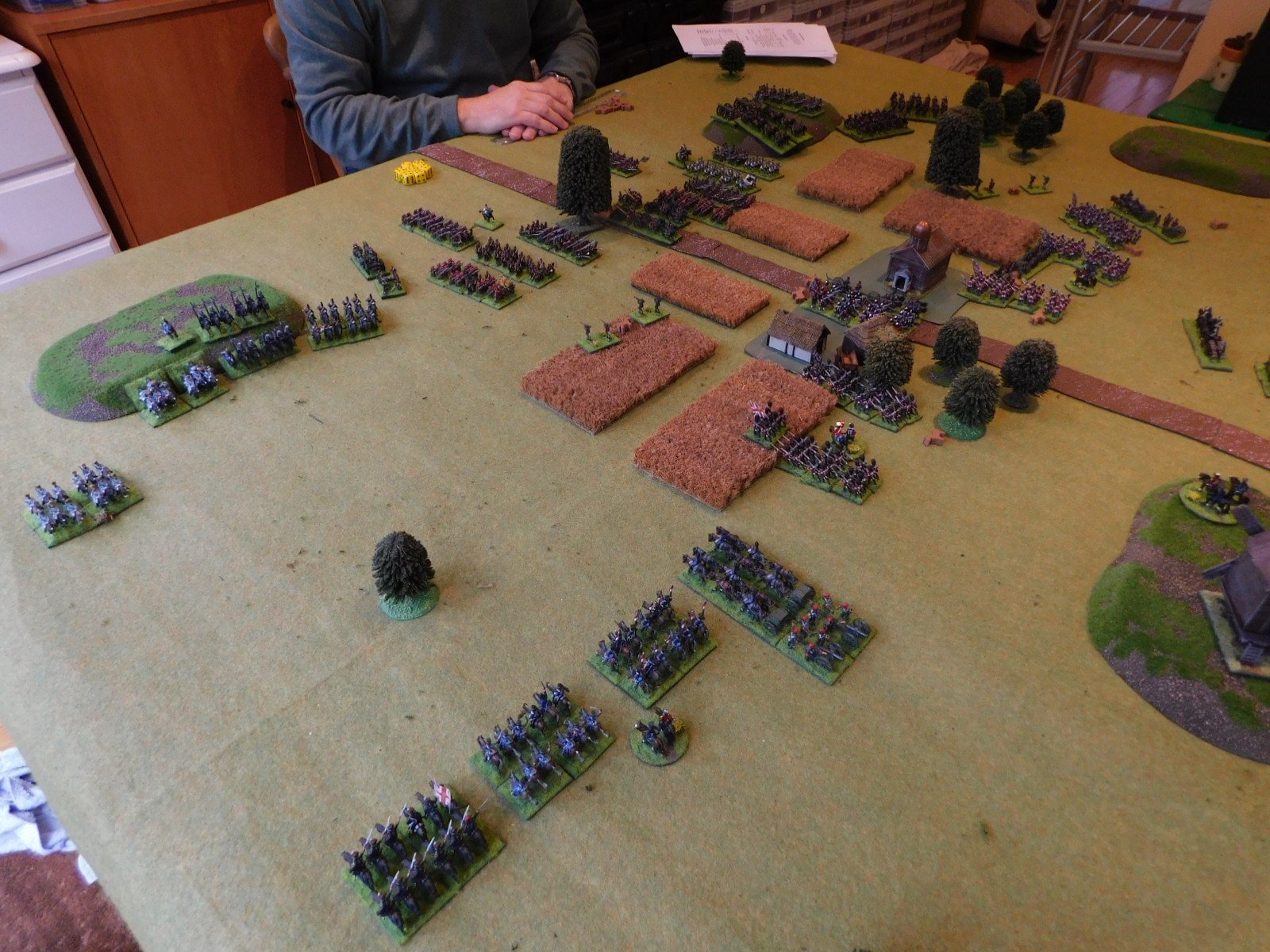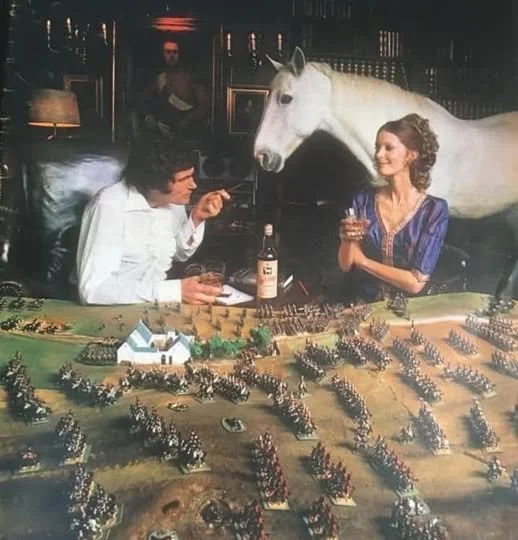FK&P AAR: The Attack on Marlowe
/A long, long time ago in a galaxy far, far away, I was at school with a chap that everyone called Fred. Not sure quite why, as that wasn’t his name, but I’m thinking it might have been because he just looked like a “Fred” in that he was very large and very strong and had a difficult to spell surname. Or it might have been because he bore more than a slight resemblance to the Scooby Doo character, assuming that Fred Jones lifts, that is!
Fred and I used to wargame at school - mostly Ancients using WRG 6th - but lost touch after he swapped to doing the real thing and joined the army. Flash forward many years and he was now out, had seen me on Linked In, and made contact again. We met up shortly afterwards for a drink or three, and from there it was a very easy transition to arranging a game.
Gaming is very different now to what it was then. In those days, the early to mid-eighties, nothing was quick and nothing was small: a battle was a whole day or weekend affair, minimum, with thousands of 25mm figures on the tabletop and an allowance built into the session’s timetable for colossal, life-threatening rules disputes involving such matters of importance as fractions of inches or degrees; the definition of charging in a straight line; or line of sight arguments that could only be settled by the hiring of a theodolite! Fred used to paint 25mm Minifigs’ Napoleonics with a syringe needle, for God’s Sake, in order to make sure the regimental numbers on the cuffs were legible!
I had no wish to return to those days, especially the “life-threatening rules disputes” as he was still a very large person and now presumably trained to kill, so decided upon a game of For King and Parliament, the English Civil War version of To The Strongest. FK&P is a cracking game that, to my mind, really captures the look and feel of the period to give reasonably realistic results with fast-play mechanics. It’s grid based, obviating a lot of the disputes about measuring, and driven by drawing playing cards.
We used the first scenario from my Marlowe to Maidenhythe scenario pack, with both sides acknowledging that this first game would be a training session more than anything else. Fred took the Royalists, on the attack versus my Parliamentarians.
Fred’s first question: where was the grid? It is there, but indicated in a way that doesn’t interfere with the look of the game.
I won’t describe the battle in detail, but suffice to say that it was a grinding win for the Royalists.
What was interesting, however, was seeing Fred reacting to the different challenges he faced, drawing on military rather than wargaming experience. My battalia were to be “located and fixed in place” before being destroyed by an attack from the flank, so Fred immediately understood the concept of a Zone of Control or ZoC, and proved very good at the fixing and destroying bit.
An advantage was to be “immediately followed up” with the emphasis being on a series of consecutive hammer blows rather than necessarily conserving damaged units. It was all very interesting, and we both enjoyed the game immensely.
Here are some more shots of the battle:
IABSM AAR: Action at Galmanche
/I hope that everyone can be lucky enough to play in one of Phil Turner’s excellently presented and run games of I Ain’t Been Shot Mum. I did so at one of the Operation Market Larden events, and enjoyed myself immensely.
Here’s another game from Phil that uses one of the scenarios from the rulebook. Click on the picture below to see all…
TTS AAR: Sicilians versus the Tang!
/Yes, I know it’s not any sort of historical or even geographical match up, but this is Ancients/Medieval gaming so that’s convenionally allowed!
Nice
Anyhow, it was off to friend Peter’s house for a quick game of To The Strongest using his big figures. I would play the Italo-Normans as a try out for expanding the 15mm ‘pure’ Normans that I’m currently painting up into a Sicilian army; and Peter would play a nicely painted, bring-and-buy Tang Chinese army he’d had hidden away for years.
The armies were actually quite evenly matched. The Sicilians consisted of a core of Knights, some veteran, supported by spearmen, some with bows, and some lights. The Tang had a core of cavalry and cataphracts supported by, you guessed it, some spearmen and some lights, with his troops having extra crossbows rather than bows.
The Sicilians were outscouted and, I must confess, out deployed. On my left flank, all my cavalry faced all the Tang cavalry. In the centre, three quarters of my infantry faced his. But on the right flank, a good 25% of my infantry were facing empty space. Doh!
Time to make the Tang an offer they couldn’t refuse!
Comparing notes after the game, both Peter and I were convinced that we would win the cavalry clash that was almost certainly coming on my left wing: Peter because he had more lights supporting his heavies than I had, me because my cavalry were a bit better quality than his. We both duly advanced our horse forward as fast as possible.
It was in this first cavalry clash that it rapidly became apparent what sort of day I was going to have: I lost both my cavalry generals in rapid succession, drawing so many Aces that Peter actually asked me whether I wanted to check I had the right number in the deck!
I had disordered two of his units in the first clash, so was posed to sweep all before me, but have just lost both my cavalry generals: they should be behind the knights on the hill and those toi their left!
The writing was fairly much on the wall from that point onwards. My cavalry, all now out of command, were gradually beaten backwards, and although a bit of good luck could have given me an advantage, those Aces kept on coming.
The photo below shows one of the moments that could have turned the game: I have lights on the flank of some disordered cataphracts, they’ve drawn a ‘2’ to get into charge position (meaning that they have an 80% chance of going in) and what do I draw? Yes, you guessed it, another Ace!
Meanwhile, in the centre, my infantry weren’t doing much better. Although both my generals were currently still breathing (that would change: I lost one of them later on in the game), I hadn’t had any success in either getting my right wing into play or even getting my centre into any sort of effective action.
With my victory medal count rapidly diminishing as my cavalry gradually gave way, the only way for me to win was to defeat his infantry quickly, but Peter cannily kept pulling back so that I just couldn’t get to grips with them. Add in losing another general to the mix to effect my ability to spur my men forwards, and you can see that it just wasn’t going to happen.
Seeing I had only a couple of victory medals left, Peter now changed tactics: coming forward and targeting my light units with everything he had. Their departure proved the final straw for the Sicilians, and they fled the field!
A most enjoyable game despite my defeat and frustrating habit of drawing Aces, and I could console myself with the fact that this must mean that next game I won’t be drawing any Aces at all…as the laws of probability work like that, don’t they?
Don’t they?
Well, they will in my decks!
IABSM AAR: North of Caen
/Here are some pictures of game Alex Sotheran has been playing using the first scenario from the I Ain’t Been Shot Mum rulebook: North of Caen. These were posted in the IABSM Facebook group.
AAR: TTS European Championships
/Friend Peter had organised a new competition for To The Strongest - the European Championships - and wanted to know if I was interested in taking part. Now I don’t really do competition battles any more: ghastly memories of arguing over minutiae in WRG 6th or similar and ultra-competitive behaviour (usually from me!) souring the experience…and the TTS tournaments are all played in 28mm and my collection, as you all probably know, is exclusively 15mm.
I checked the diary, however, and it turned out that, unusually, I had a completely free day that Saturday, so I said to Peter that I would come along and help and, if needed, make up the numbers as a super-sub should an odd number of players turn up (assume the joke about expecting an even number of odd players to turn up!).
I duly arrived at Ewelme (you-elm apparently) Primary School early yesterday morning and enjoyed half an hour of peaceful reflection eating my breakfast sandwich in an idyllic rural setting until everyone else arrived. To be honest, it was worth the half hour travel time for that alone!
Peter was lending me a Burgundian Ordnance army, so handed me a box full of troops and then it was fingers crossed to see if I would get any games…but as it happened, even numbers were present. No matter: I was happy to time keep and generally help out, and there were some spectacular looking armies to admire, even if they all looked very big to me!
About 15 minutes in, however, one of the players was forced to up-sticks and head home to sort a family matter, so I quickly grabbed the Burg’s and settled down to fulfil my super-substitute role.
My opponent, Andy, was using Almoravids: a very nice looking set of Spanish Berber types, all of whom were already deployed and ready to rock. We agreed that keeping to the tournament schedule meant we couldn’t go through the usual scouting, terrain and deployment process, so I just slammed the Burgs onto the table in a long line and off we went.
I am about to sub in for John, on the right
It was a great battle. The very first javelin thrown by the Almoravids went straight through my CinC, Charles the Bold’s, visor and killed him instantly! I followed that up by managing to draw five Aces in seven cards and it looked as if a hideous defeat was about to follow…but the Burg’s are a resilient lot, and somehow managed to fight their way back to a 100:73 point victory. I do remember one set of Knights smashing the Black Guard from the table in one charge, and killing a couple of enemy generals, but not much more than that!
Then it was onto game two: fighting Michael and his Later Italian Condotta with Swiss Allies, or Venetians for short. This was another cracking game, involving my Knights coming up against some very menacing looking pike blocks. Star of the show was my little Organ Gun artillery unit, which held up the Swiss pike block for two or perhaps three turns as it marched relentlessly towards my camp. The crew of said gun even managed to do the Swiss some damage in the melee! This stout and quite frankly incredible defence allowed me to get some Knights onto the Swiss flank and, much to the shock of all concerned, send them fleeing for the rear. Much to my surprise, another win at 108:58 points.
At this point we broke for lunch and a tour of the school-church-alms house complex, all built by Alice Chaucer, thrice-married grand-daughter of Geoffrey, and the first female Knight of the Garter. Fascinating stuff that included a secret stair and the minstrels’ gallery where Henry VIII allegedly first, er, succeeded, shall we say, with Anne Boleyn.
Onto the afternoon session, and bad news for the super-sub. Another player had withdrawn from the tournament meaning that numbers were uneven again. I was all prepared to return to the bench when someone else, Mark to be exact, said that they would be happy to sit this game out to give me another go. This was gentlemanly behaviour in the extreme, so it was time to face Chris and his Later Swiss. More pikes!
This, third game was also excellent. The Burg’s were caught napping, out-scouted and then pinned back against the edge of the table by some extraordinarily fast marching from the Swiss (I still don’t know what they do with their pikes when acting as mounted infantry LOL). I was sure I was doomed, and told Chris the same, but he assured me that all was not lost…a bad mistake on his part as his prophesy began to come true. Still pinned against the edge of the table, a camp lost to the enemy, the Burg’s stuck their heels in and began to push back. A couple of enemy generals were dispatched (it was a bit of a theme for the day) and some non-pike units broken, but it was a combination of missile-fire to disorder then send in the Knights to punish, which finally broke a Swiss pike block sending loads of victory medals my way. If we’d played on, the game could still have gone either way, but I ended the winner with a score of 102:79 points.
At that point I returned to the substitutes’ bench and spent a very enjoyable couple of hours wandering around the games, admiring both the action and all the very lovely figures on display.
Time for the results and I was amazed to find that I had come fourth. This was obviously partly due to the bye I had received in the fourth round, but was very welcome news indeed. Even more surprising (doubtless particularly so to those who have gamed against me!) was that I was also voted Most Chivalrous Player of the day. Even my family were gob-smacked by that one!
So many thanks to Peter for organising a great day, and for everyone else there, particularly my three opponents Andy, Michael and Chris. I had a whale of a time and am now wondering from whom I can borrow an army for the next one!
IABSM AAR: Russian Civil War Action
/The core I Ain’t Been Shot Mum system is really very flexible indeed, and here’s an example to prove my point.
Taken from the IABSM Facebook Group, here are some pictures of a Russian Civil War game played by Lee and friends. Technically 20-odd years prior to the period, and ran very smoothly:
I love the sabot bases: they work really well.
Overlord 2023/Valour & Fortitude
/I went to Abingdon Wargames Club’s Overlord 2023 show at the weekend. This was the first one back after lockdown and COVID, and a very pleasant little show it is too.
Whilst it’s not the biggest show in the world, it had all the important elements needed: demo games, trade stands, car-parking, reasonable food and drink, and only a £4 entrance fee.
I didn’t buy anything, for a change, I’m still painting Normans and working on the lead mountain, but I did get to play in a very nice 6mm game of Valour & Fortitude: the fast-play, skeleton Napoleonic/19th Century rules from the Perry twins.
It’s quite a brutal game, in the same style as the Neil Thomas rules I have been using for the post-Napoleonic 19th Century period, in that battalia take a few hits then go shaken then are removed from the table, all of which can happen in one round of melee…but it was a fun encounter where myself and a chap who’s name I didn’t catch, as the French, successfully defended a river/bridge against large numbers of Prussians.
My thanks to Si, Mark and John for running the scenario, and to my opponent and fellow player for making it an enjoyable game. As I said, above, the French hung on, just, for long enough to win…but it was the very narrowest of narrow victories!
If you can get to Abingdon without too much trouble, put Overlord into your diaries for next year: definitely worth going to.
TTS AAR: Vikings Resurgent!
/Time for a quick game of To The Strongest. Today’s game would feature the Vikings, commanded by Yours Truly, versus the Burgundian Ordnance, commanded by John.
The yellow caps are lance markers, the red meeples indicate veteran Huscarl units.
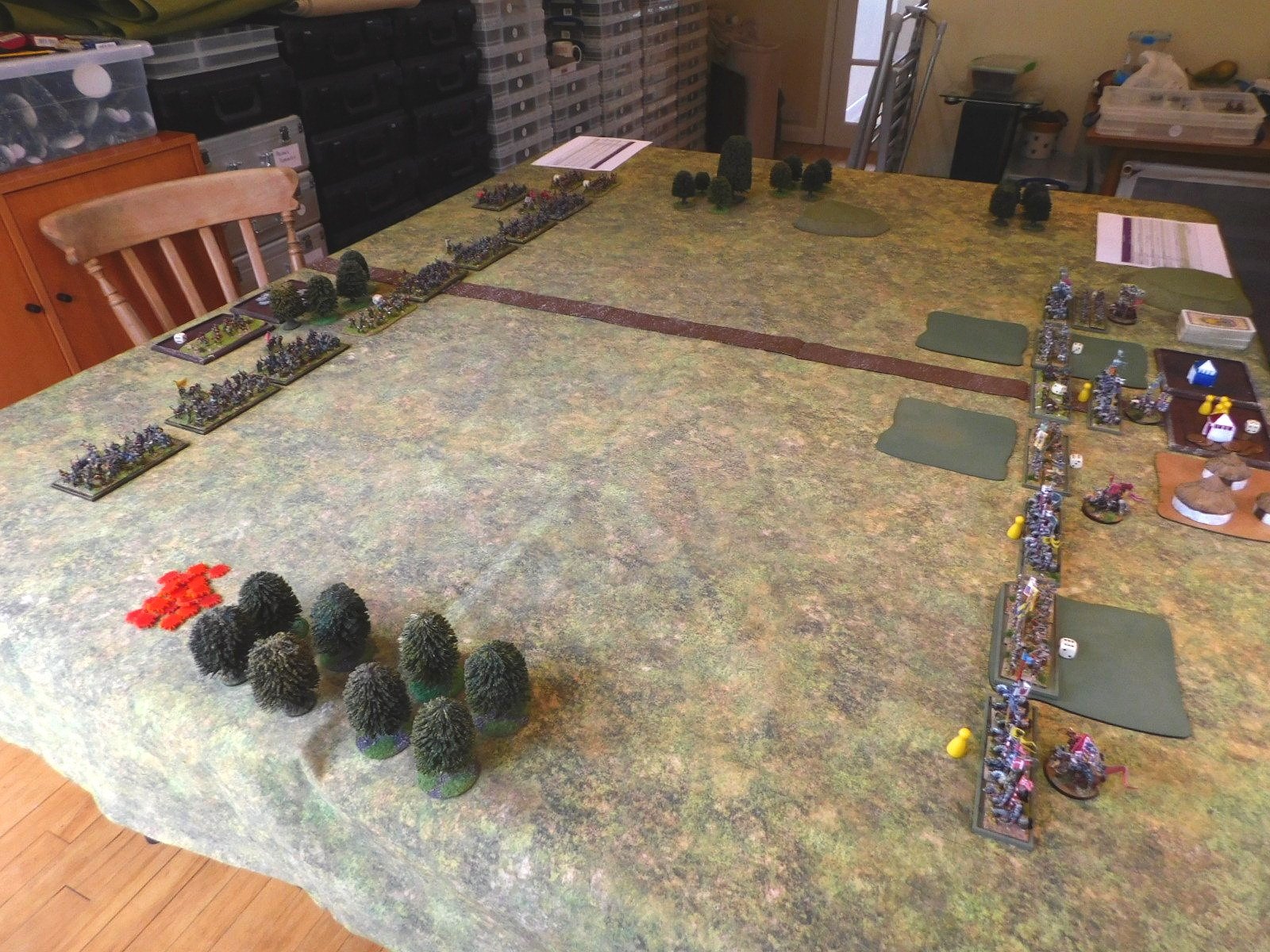
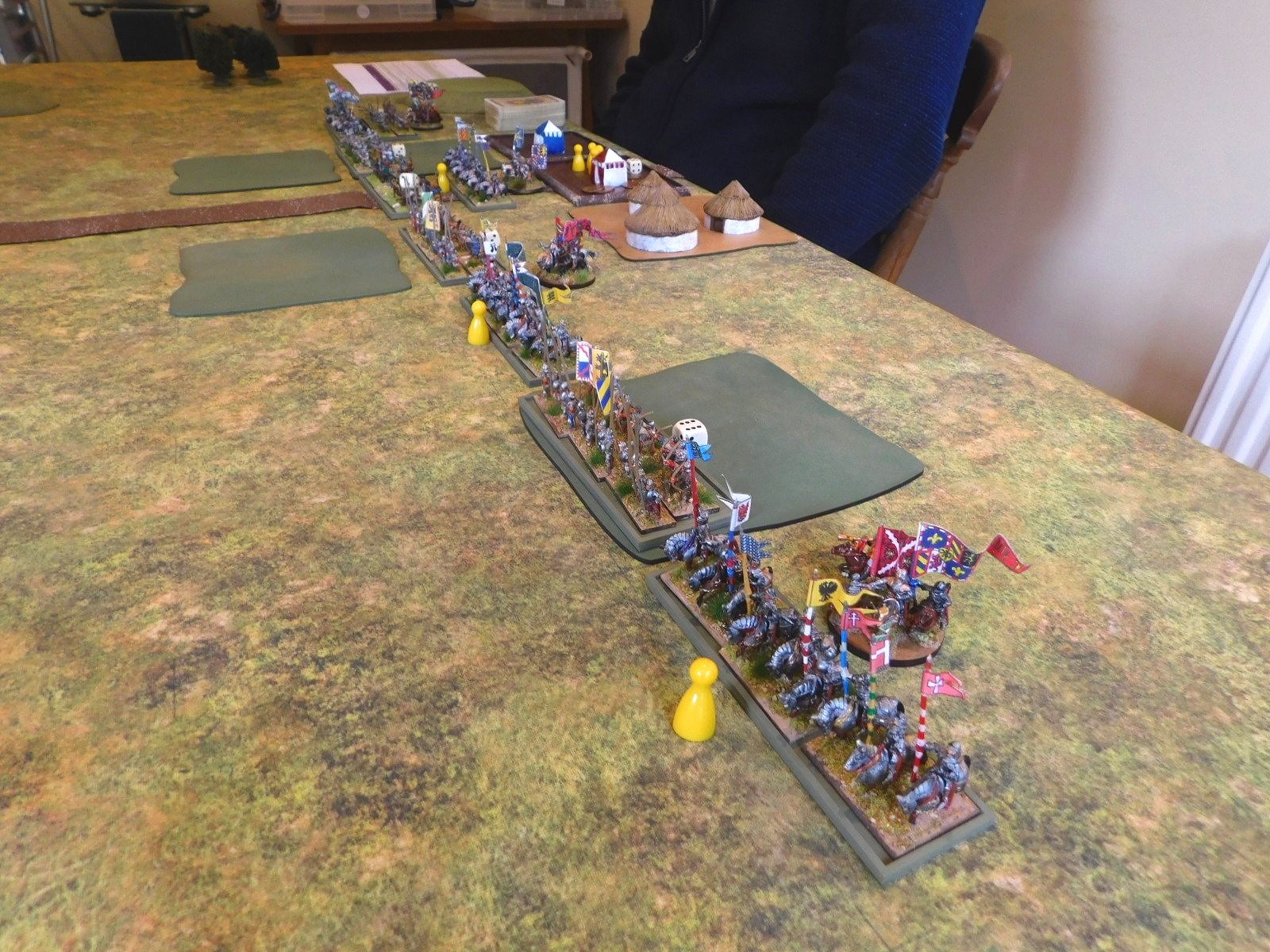
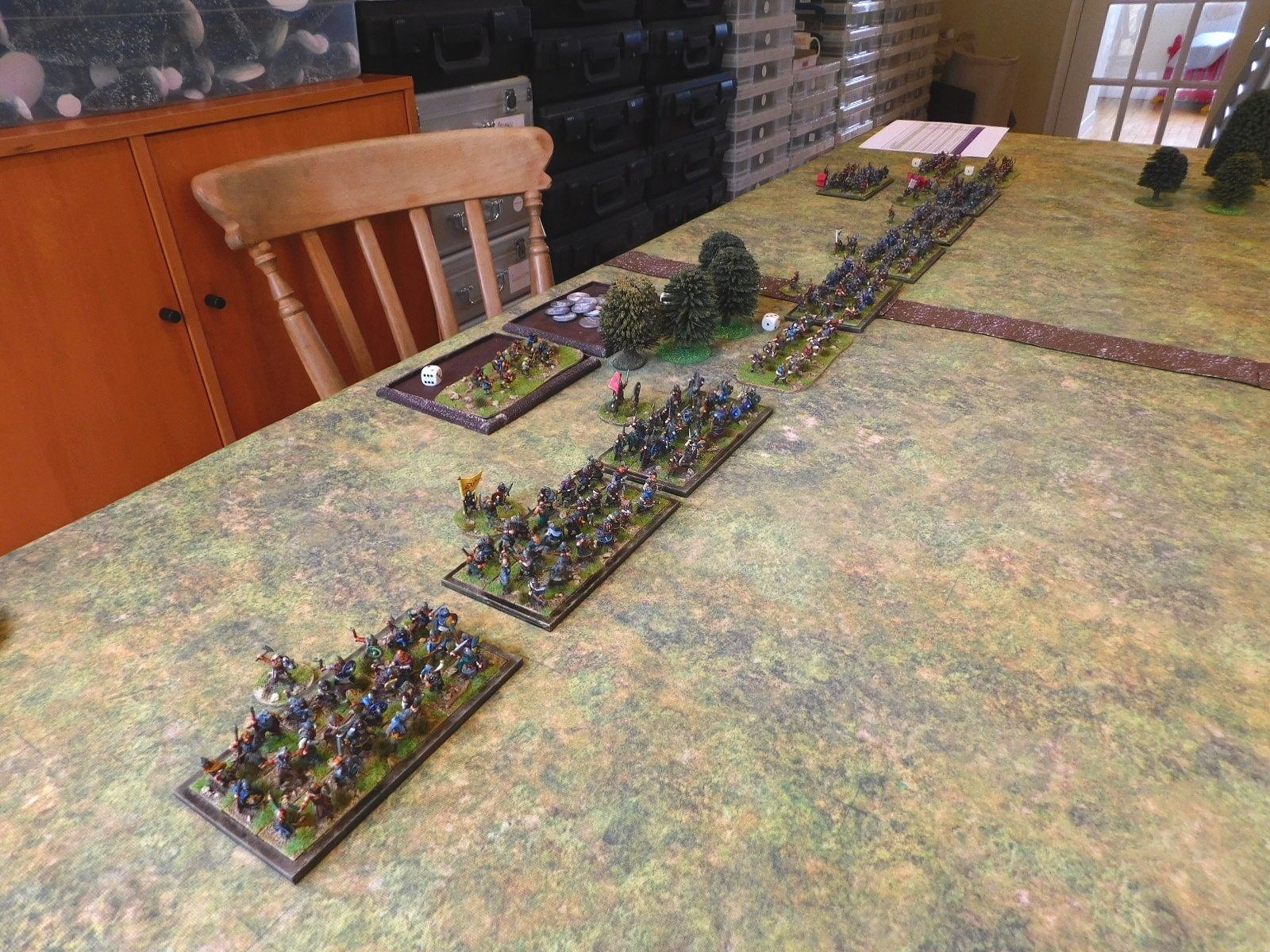
Two very different armies: my Vikings are a foot-only army comprised mostly of big shieldwall units (I’ll call them warbands) with a few lights thrown in; the Burgundians are a combination of lethal and indestructible Knights with some useful missile-armed spearmen in support.
I knew I would lose if I let the Burgundians pick me off one unit at a time: the only way to win was to move forward and attack en masse so that my battle line could absorb the initial charge of his Knights then swamp them with numbers.
I also knew that my light bowmen were useless against the Knights (the arrows would just plink off!) so determined to send both light units up the far left flank and try and get behind his battle line and into his camps, knowing that he didn’t have enough units to face my warbands and defend his rear.
I therefore moved my warbands forward in a long line, being careful not to let the more impetuous Vikings surge forward in an uncontrolled manner.
This meant that when the main lines did clash the outcome was exactly as I had predicted: the warbands hit by the Knights were badly disordered at first contact but not destroyed, and then other warbands piled in to help.
Keep your eyes on the light units to the far left as well: they are doing what they were supposed to do!
By now I was whittling down his army, especially on my right flank. With so few Burgundian units on the table, he just couldn’t afford to lose many and, as we reached the climax of the battle, I had wiped the four units on his left and left-centre for the loss of only one of my warbands.
That meant that I only really needed one big push to win the day and, rather pleasingly, that came from (yes, you guessed it) one of my light units finally taking the first Burgundian camp.
With half their army destroyed and their baggage taken, that was enough to send the neo-Frenchmen packing: the Vikings had won the day!
CDS AAR: Valley of Tears at Winter Wonderlard 2023
/Yesterday saw the annual Winter Wonderlard Lardie Day in Bristol.
I couldn’t be there myself (real world interfering with gaming again!) but here’s the first of the AAR using TFL company-sized rules from the day, with Steve Blease and his “Valley of Tears” Golan Heights scenario using Charlie Don’t Surf .
There were two sessions: see pictures from both, and others taken on the day, by clicking on the picture, below:
TTS AAR: A Defeat for the Legions!
/Time for another game of To The Strongest with John.
Rather than play a standard pick-up game where each side lines up on opposite sides of the table, we went for a more scenario based encounter, with the Romans starting the game in three columns: their main legionary force in the centre, their horse to the right and their lights to the left. The Celtic types facing them were largely deployed as one might start a standard game, but with enough exceptions to make things interesting.
To have any chance of victory, the Romans needed to deploy for battle as soon as possible: a task completed fairly easily as the superb drill of the legionaries kicked into play. There was a gap in the line on the road itself: the Cohorts VIII and IX not performing as expected!
Note that the yellow markers indicate that the Romans have pila ready to use.
The Celts announced their intention to move forward en masse. Their wings duly did so, but for some reason (the vagaries of the cards) their centre units hung back. This gave me a real opportunity to defeat them in detail on either flank before turning to crush their centre.
On the right, my single unit of legionary cavalry, supported by some auxiliary horse archers, duly moved forward to engage the enemy horse and chariots rapidly trying to curl around my flank. I also brought four cohorts of infantry (two units in TTS terms) across in support.
This really was a good opportunity to win on this flank, but the Gods decided otherwise: consecutive 2’s drawn from the pack meant that my legionary horse sat stationary rather than charging home.
My supporting legionaries were, however, able to charge home, dispersing the Celtic cavalry in front of them (kudos to the single Cohort X base for its contribution to the fight) but this wing was still very much in dispute rather than going my way.
Things weren’t going my way on the other wing either. For some reason, my main legionary force, including the double-size Cohort I with the aquila or Eagle Standard, also hung back, meaning that rather than fighting two enemy warbands with two Roman units, I now risked a delayed fight tying up my units until they were overwhelmed by more Celts coming into the fray!
And so it came to pass: the Celtic warbands in the centre ‘woke up’, and headed forward…
It would now be much more of a traditional stand up fight, and all would be well if I could get the Roman ‘mincing machine’ into action: I needed to bring my men together, make full use of my remaining pila, and rotate units in and out of the front line as required.
Unfortunately none of that happened!
Having split my line to deal with each wing of the initial enemy attack, I couldn’t get free enough of the rampaging Celts to get it back together again. So rather than fighting as one command, my Romans had to fight as three isolated commands on the left, in the centre, and on the right.
Secondly, my legionaries had obviously packed their pila away for the march, as not a single volley had any effect on the opposition. I also suffered a wave of officer casualties including the two tribunes commanding the main body of the legion. On top of that, even John remarked that the cards had turned against me: I was missing hits that should have gone in and failing saves that should have been easy. It was just not the Romans’ day!
My cohorts were gradually disordered and then wiped by the Celts using their superior numbers, and I just didn’t have the coins to withstand those losses for long.
So a defeat for the Romans probably stemming from my failure to wipe the enemy wings at the beginning of the battle. I’d made a bold tactical decision that had a good chance of success, particularly on the right, but it hadn’t worked and I’d suffered the consequences against the remorseless Celtic hordes commanded by John!
CDS AAR: Valley of Tears
/We're not in Vietnam anymore...
Steve Blease ran through his 6mm Yom Kippur 'Valley of Tears' CDS variant game which he'll be running at the Winter Wonder Lard III Lardy Day in Bristol later this month. Here are a few shots of the action:
19thC AAR: Battle in the Crimea
/Having recently re-based all my British Crimean figures, it was time to get them onto the tabletop. Like some of my other 19thC figures, these troops hadn’t seen the light of day for almost twenty years: a testament to my inability to sell or give away any of my collection!
As I had done all the work, I would take the British, with friend John taking the Russians. Set up was a simple one: both sides were after possession of a strategically important village in about the centre of the table. We would use the Neil Thomas Rules for Wargaming the 19th Century.
As the game begun, both sides hotfooted it towards the village.
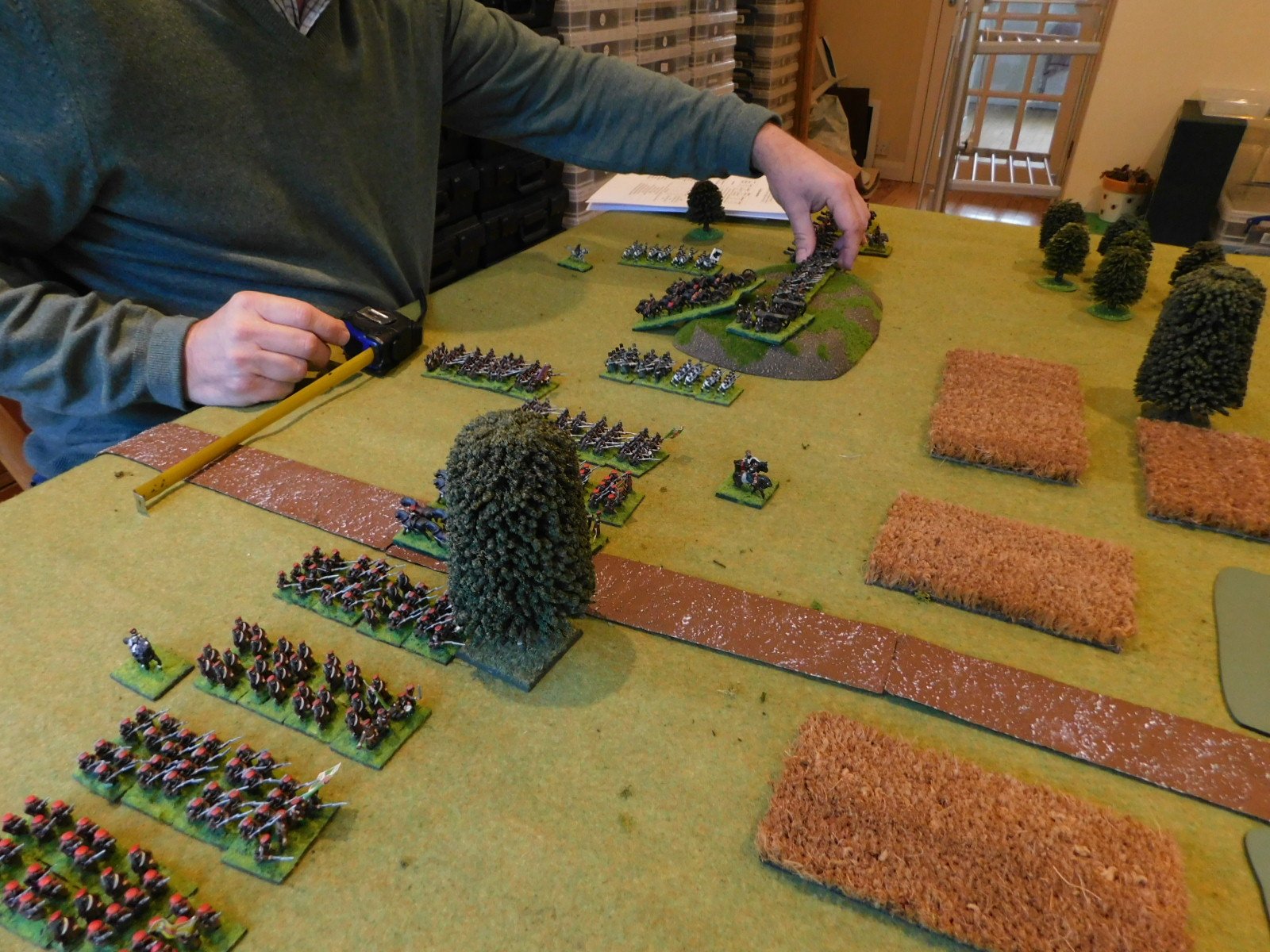
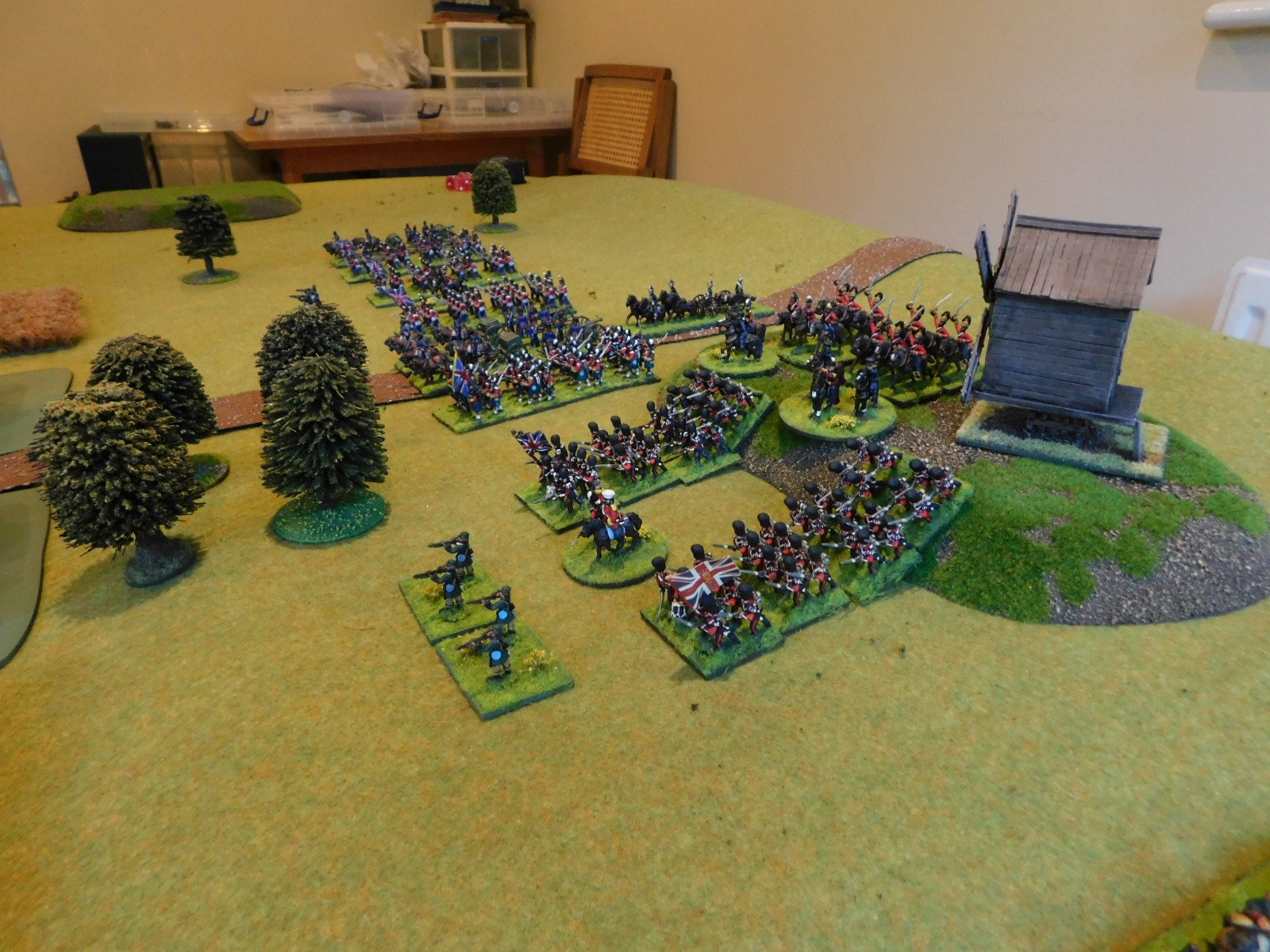
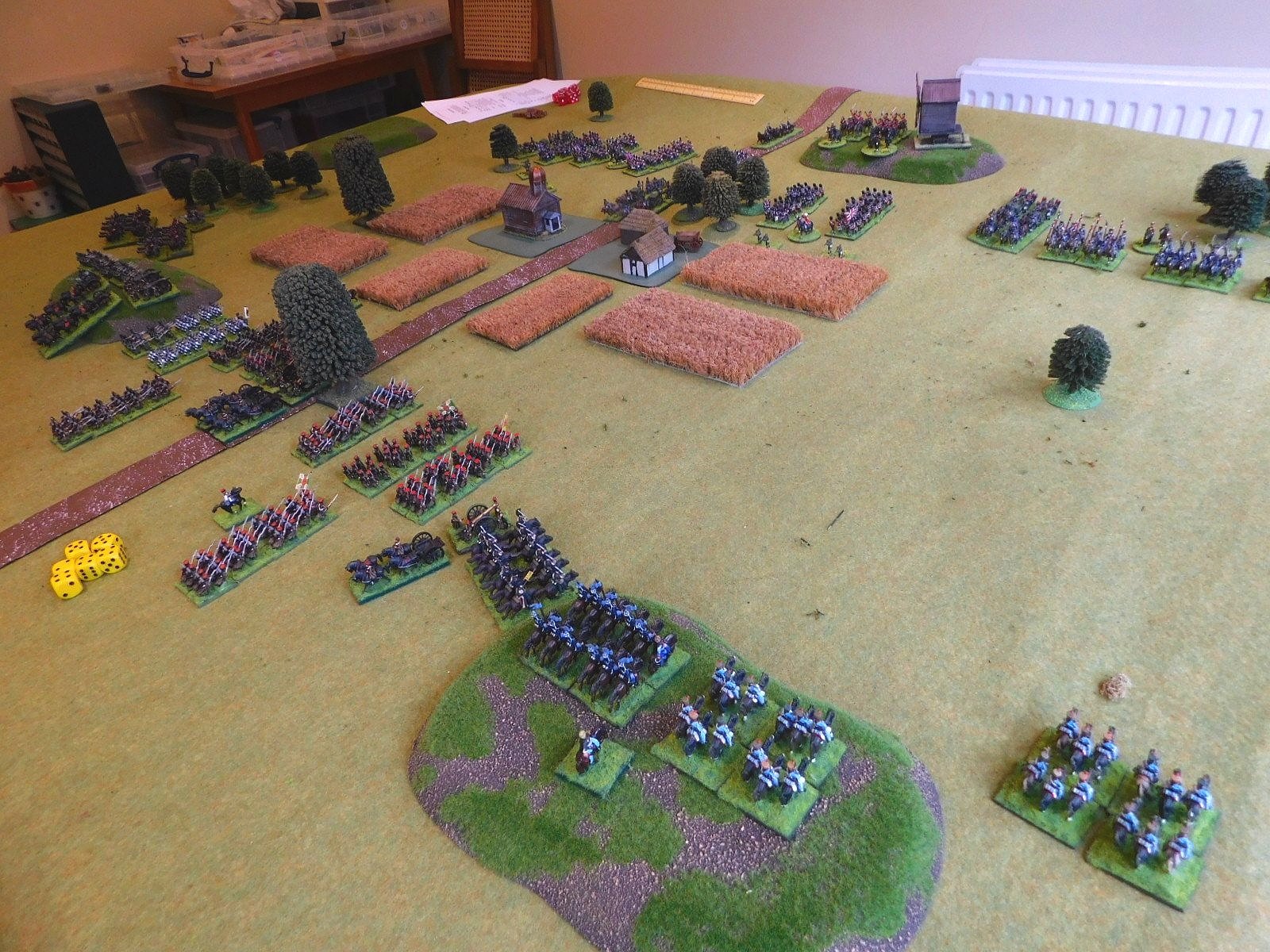
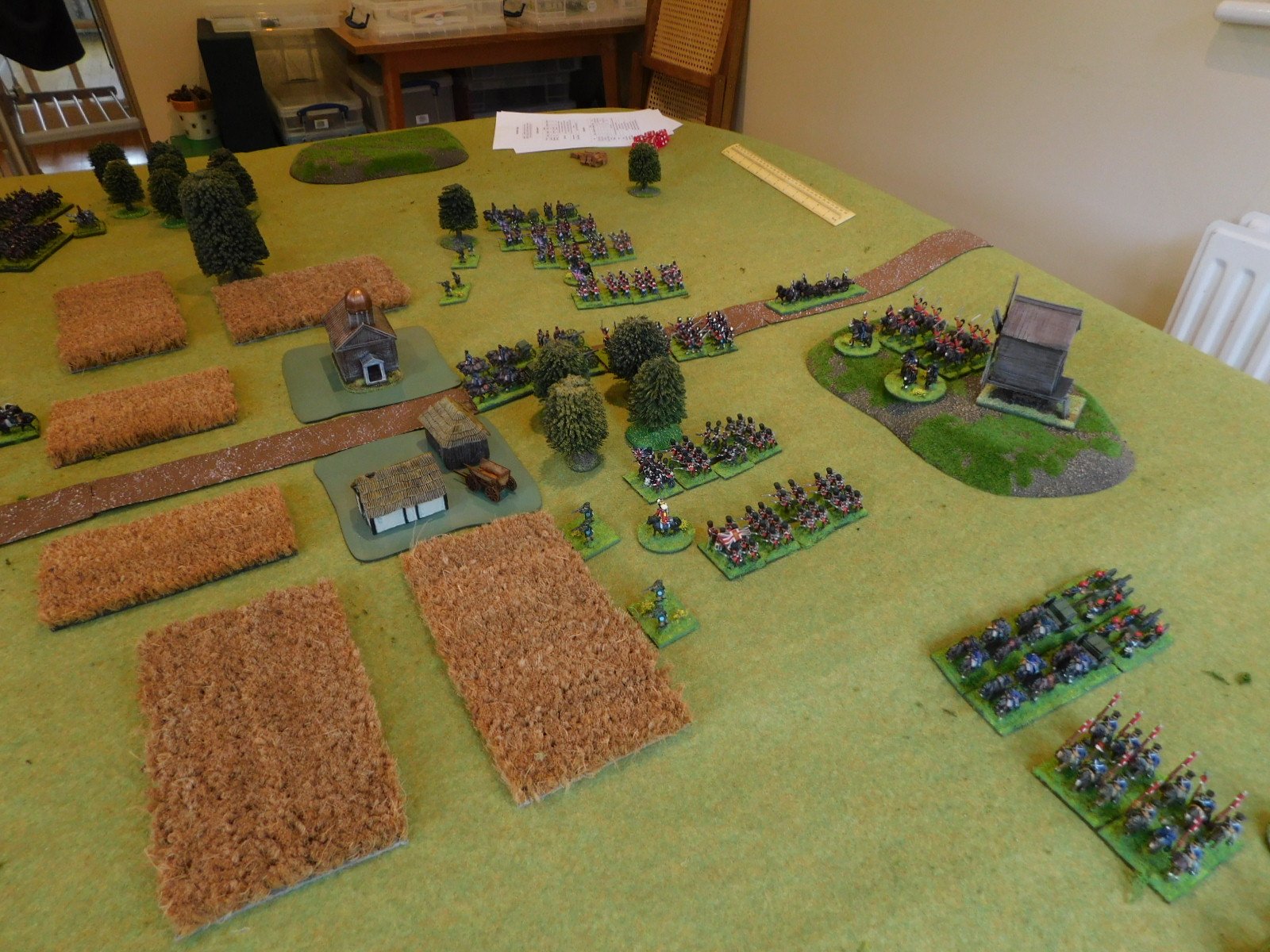
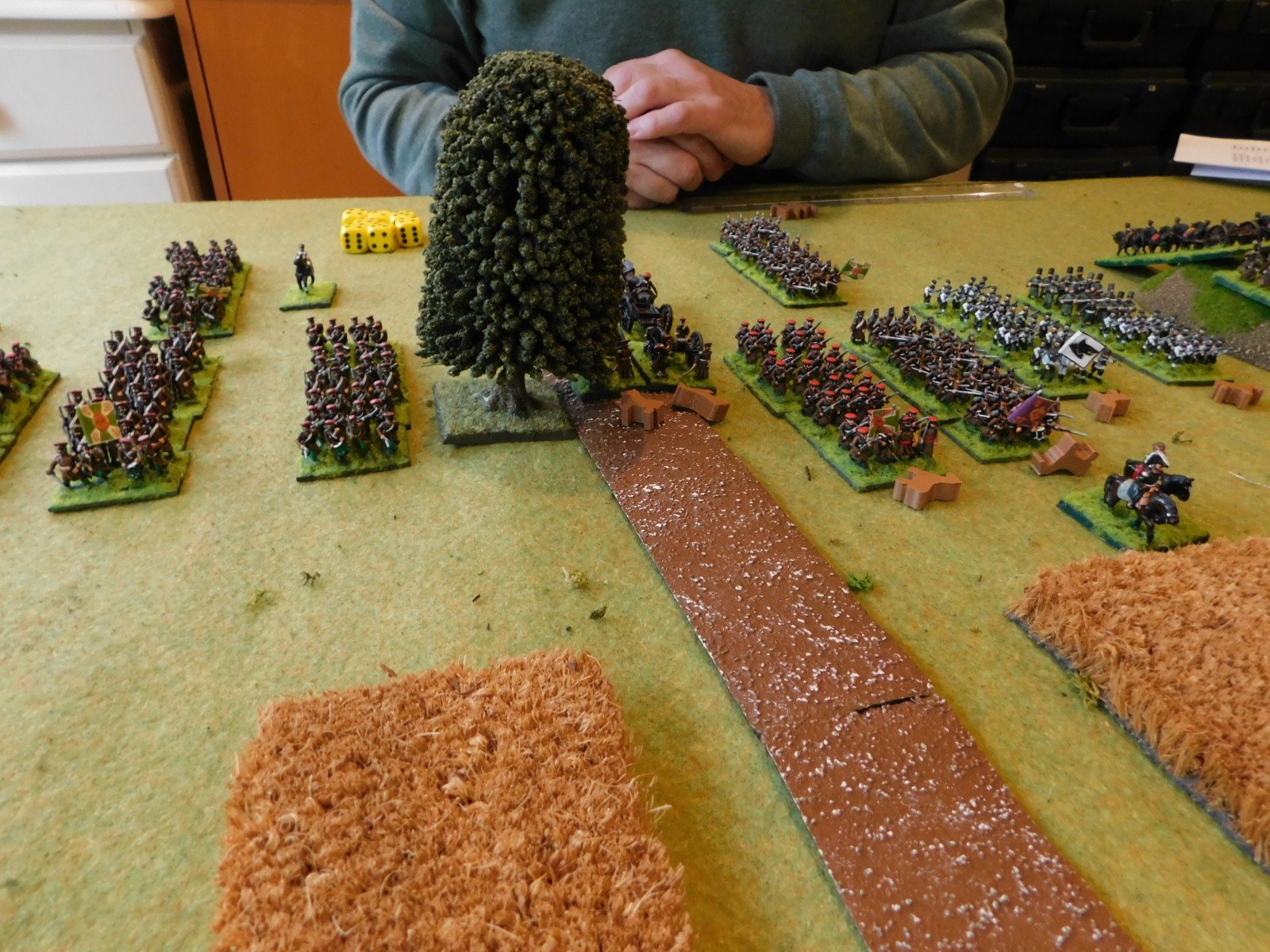

As you can see, the Brits were a bit faster (and maybe closer, but we rolled for sides!) so managed to get into the village before the Russians. Also note the opposing sides’ cavalry moving towards each other slowly on the near flank.
Before we move on with the narrative, here’s a great shot of the British during their approach:
The Fight for the Village
The British reached the village first and barely had time to form line before the Russian columns started to charge home.
On The Right
On the right hand side of the field, a British battalion supported by skirmishers faced off against two large masses of Cossack horse supported by heavy artillery and a battalion of Cossack foot.
Throughout the rest of the game, this battalion would hold this flank, sending the three Cossack units flying back to their steppes. The price was high: only half the British infantry were still on their feet at the end of the battle.
On The Left
On the left hand side of the field, the British cavalry slowly advanced towards their opponents: the plan was to protect the left flank then, once the Russian infantry were fully committed to the village, to smash the enemy horse from the field before looping around the Russian rear.
Unfortunately, although the flank was indeed protected throughout the game, when the British cavalry did eventually commit to combat, the result were…mixed! There was certainly no rapid smashing from the field going on and the situation developed into a grinding melee that lasted until the end of the battle.
The British eventually probably had the best of the encounter, but their cavalry had done all they were going to do for the day: no looping around the rear was going to occur.
This was very disappointing, as I was expecting the cavalry to quickly carve through their opponents and then go on to wreak havoc in the Russian rear.
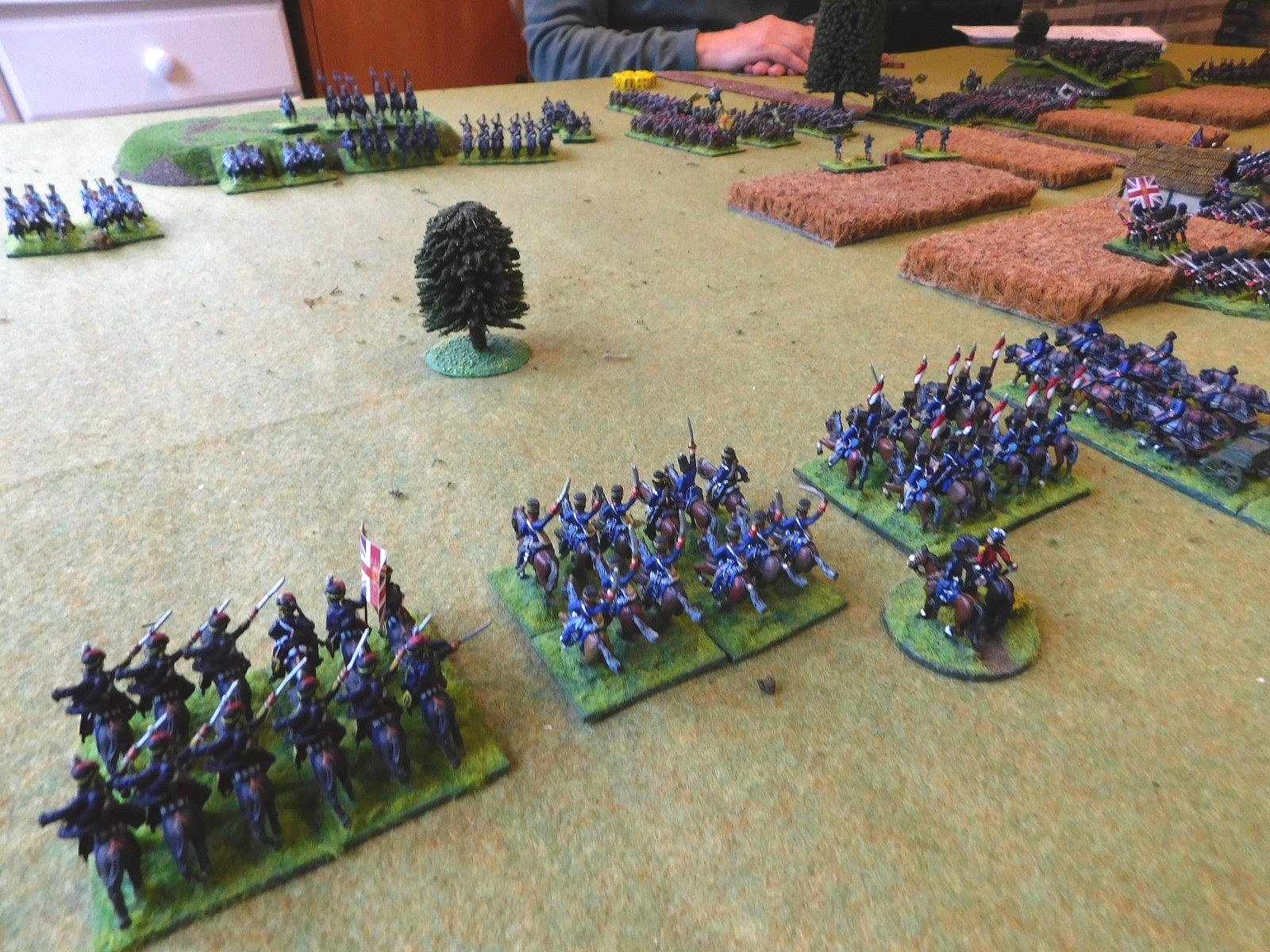
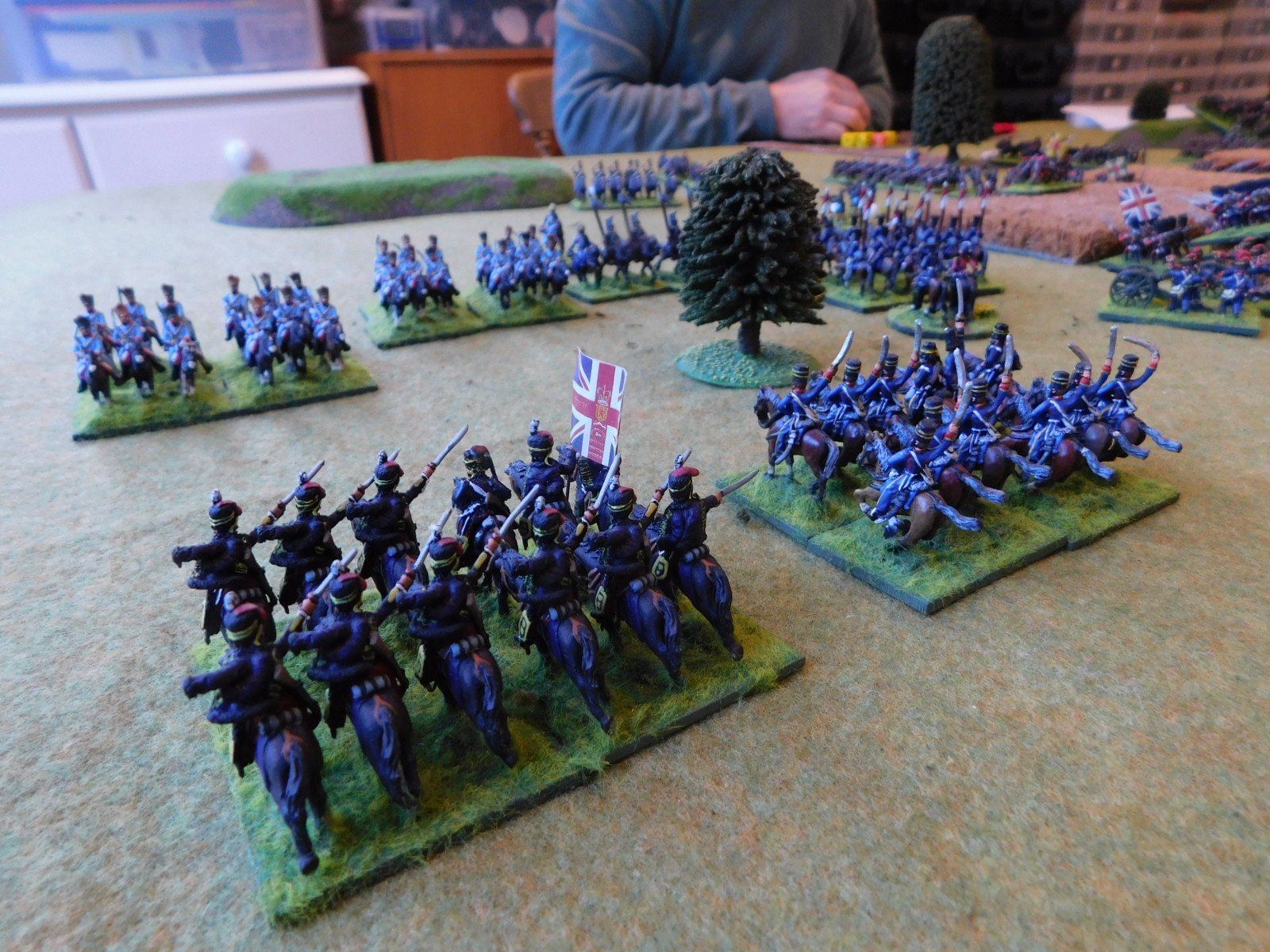
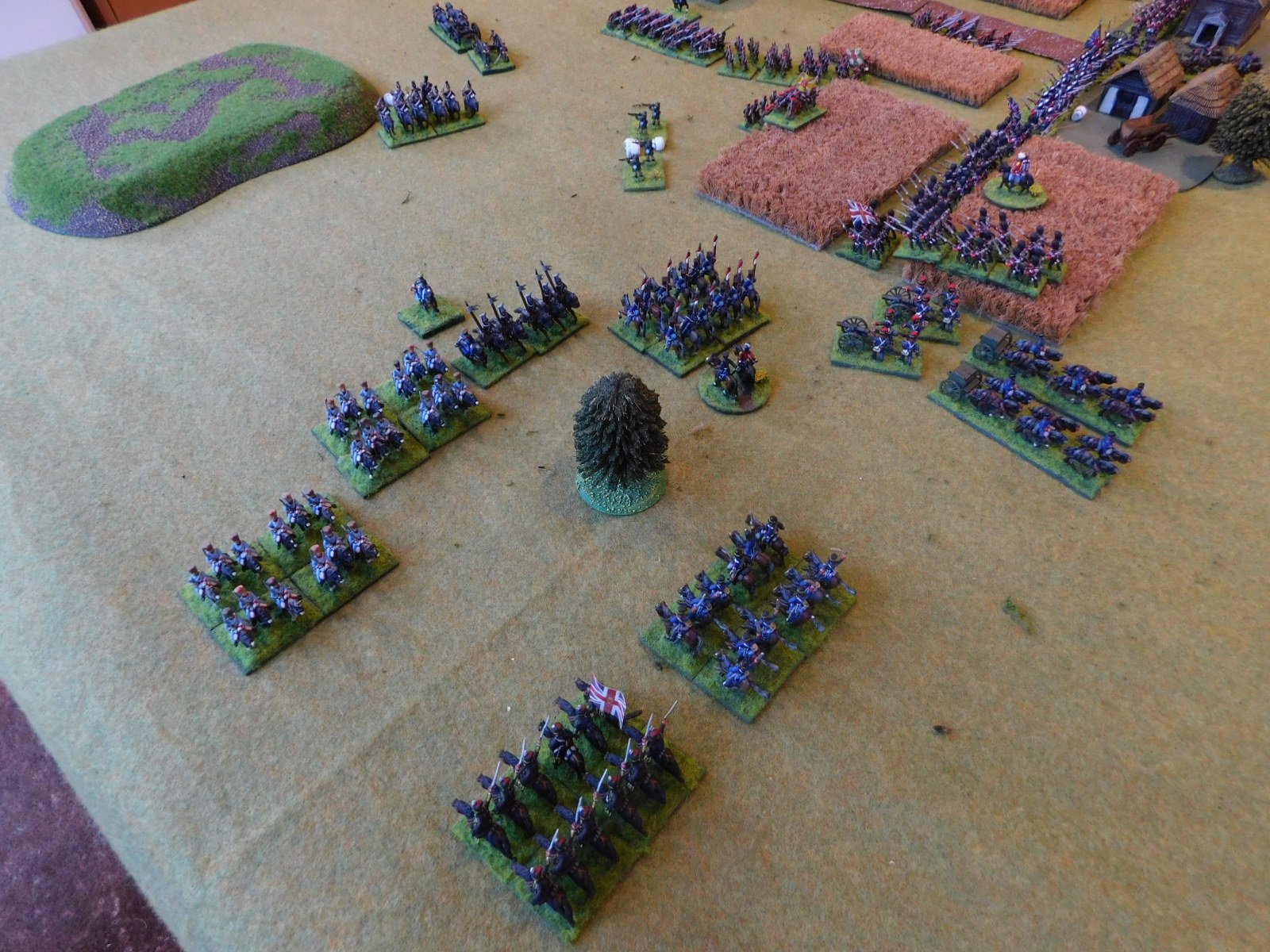
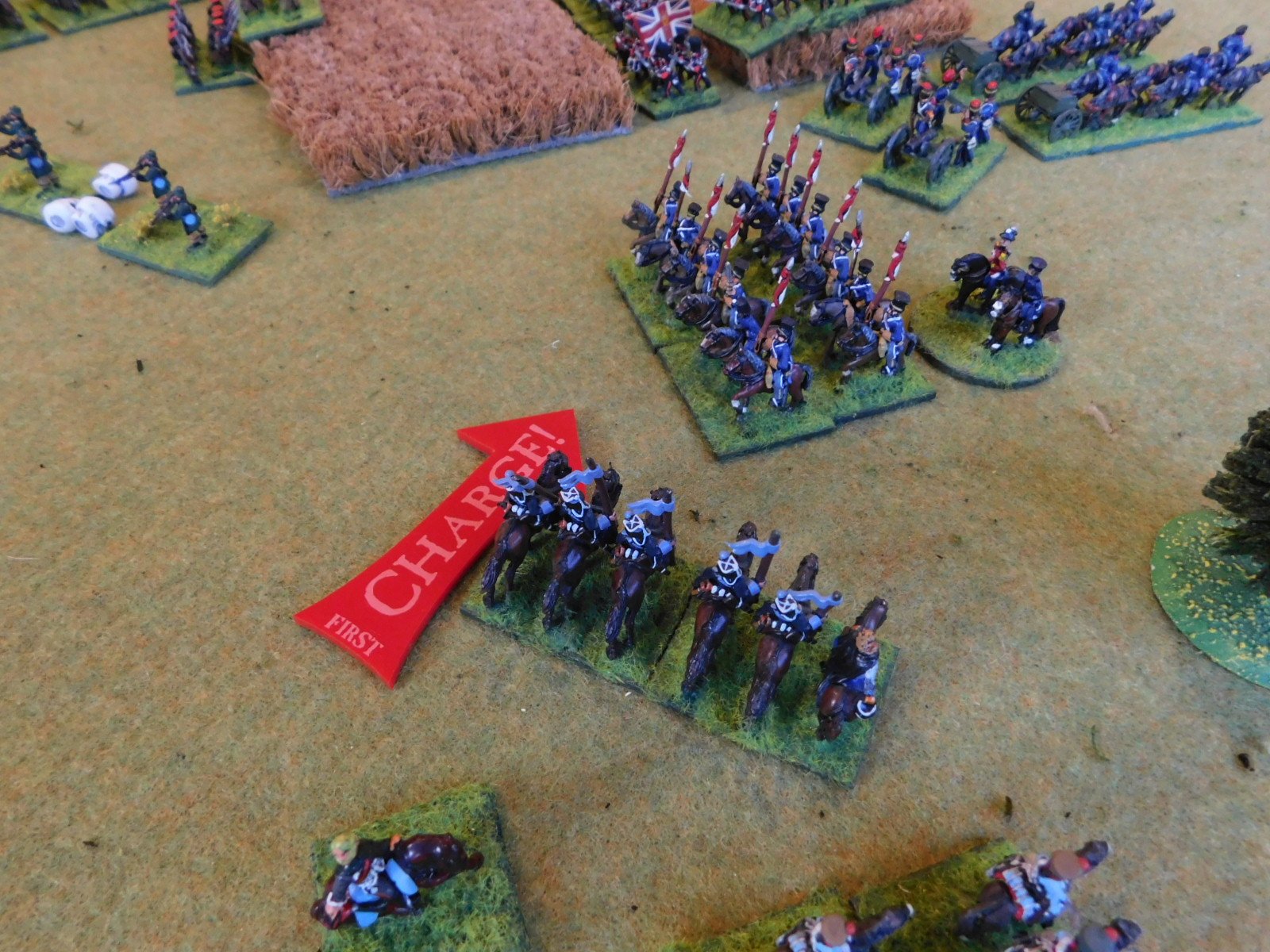
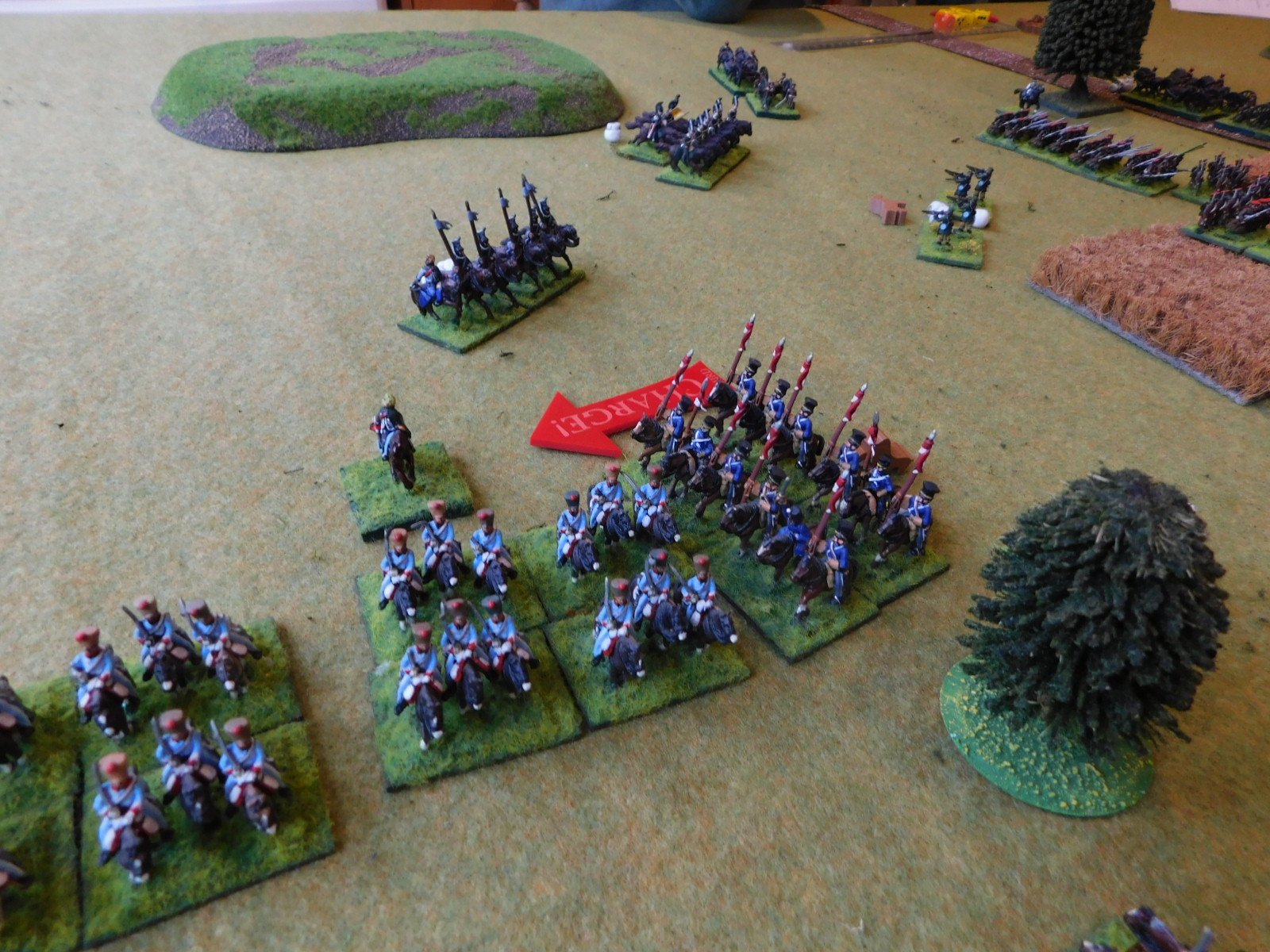
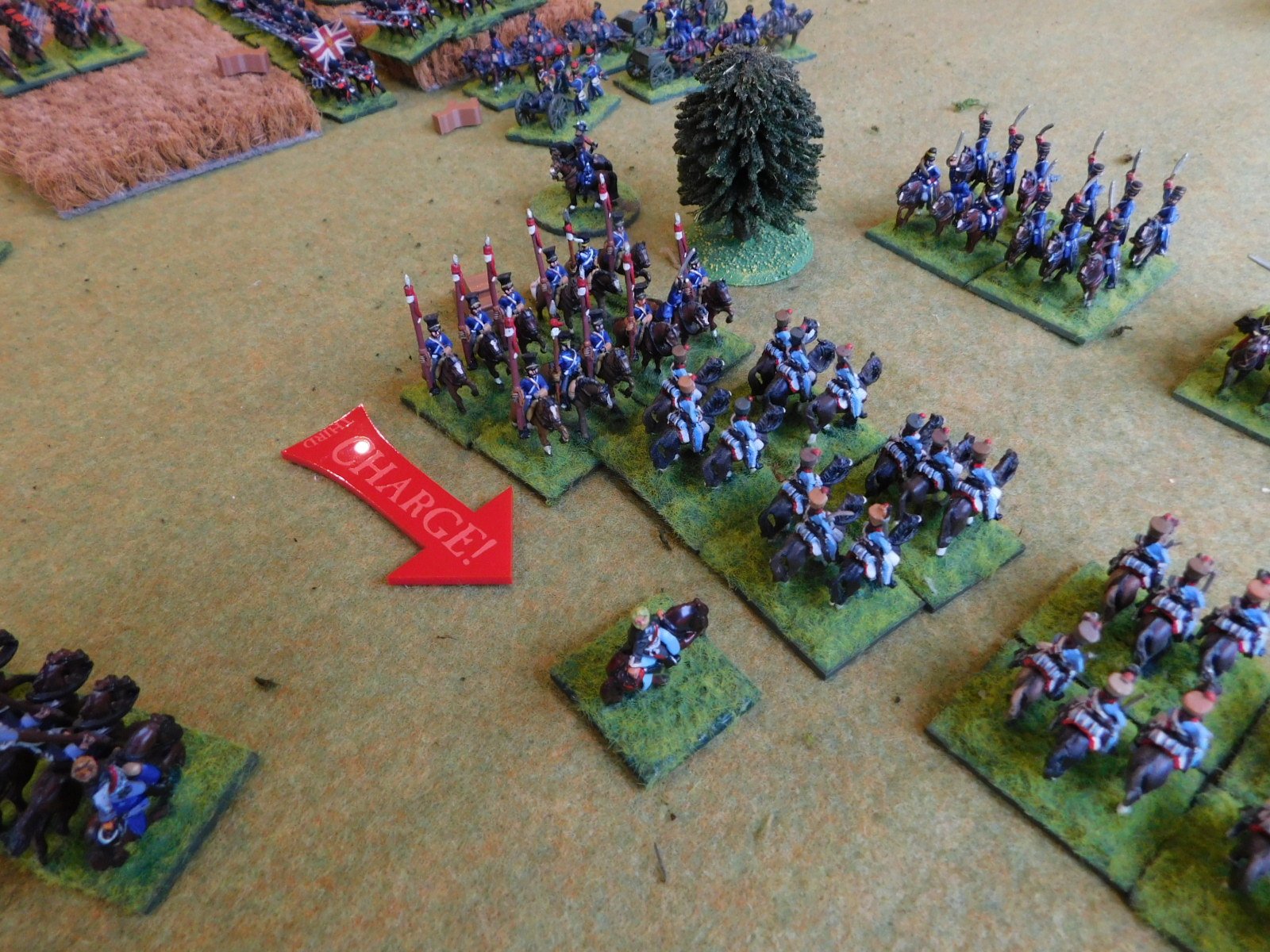
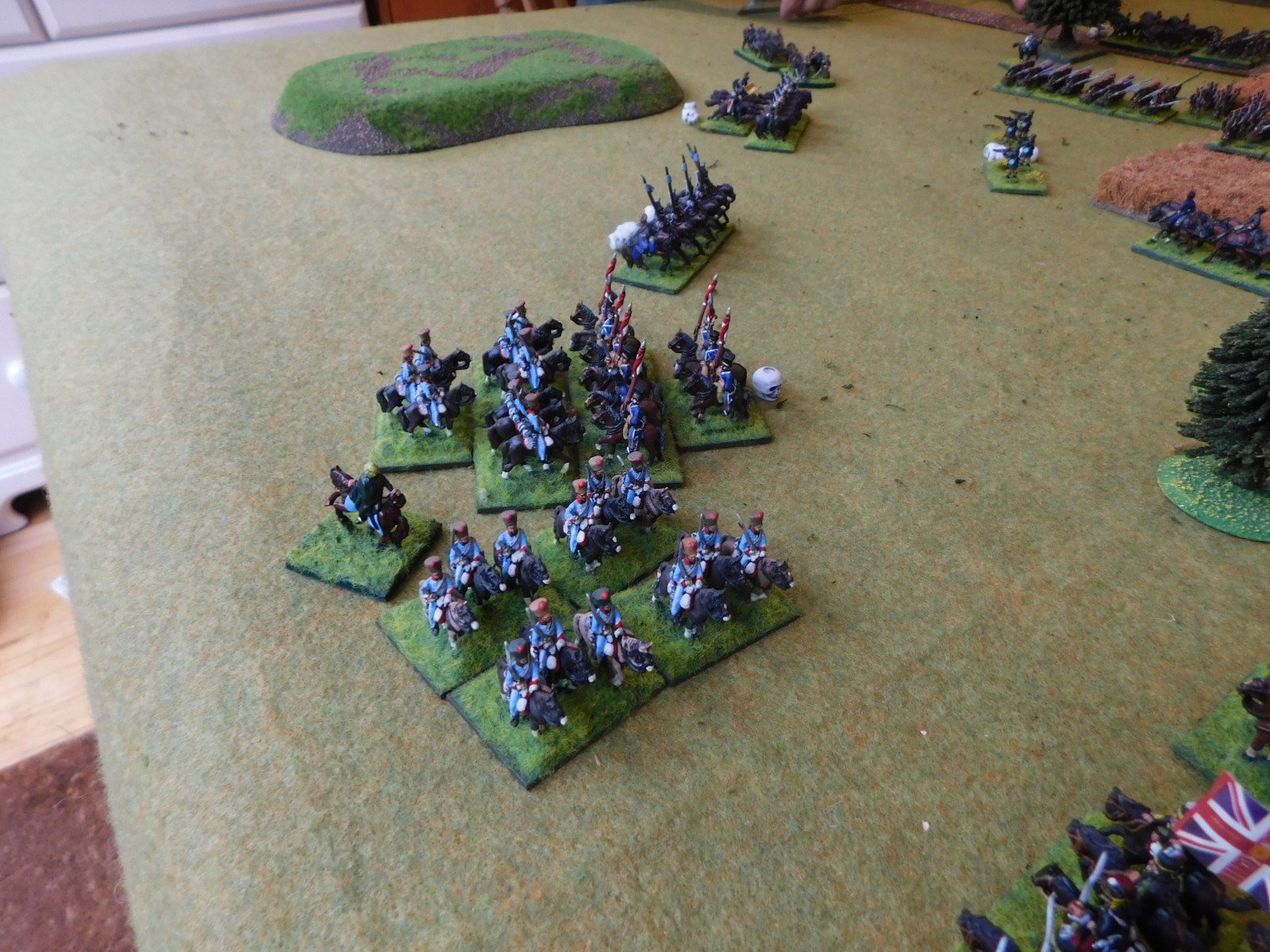
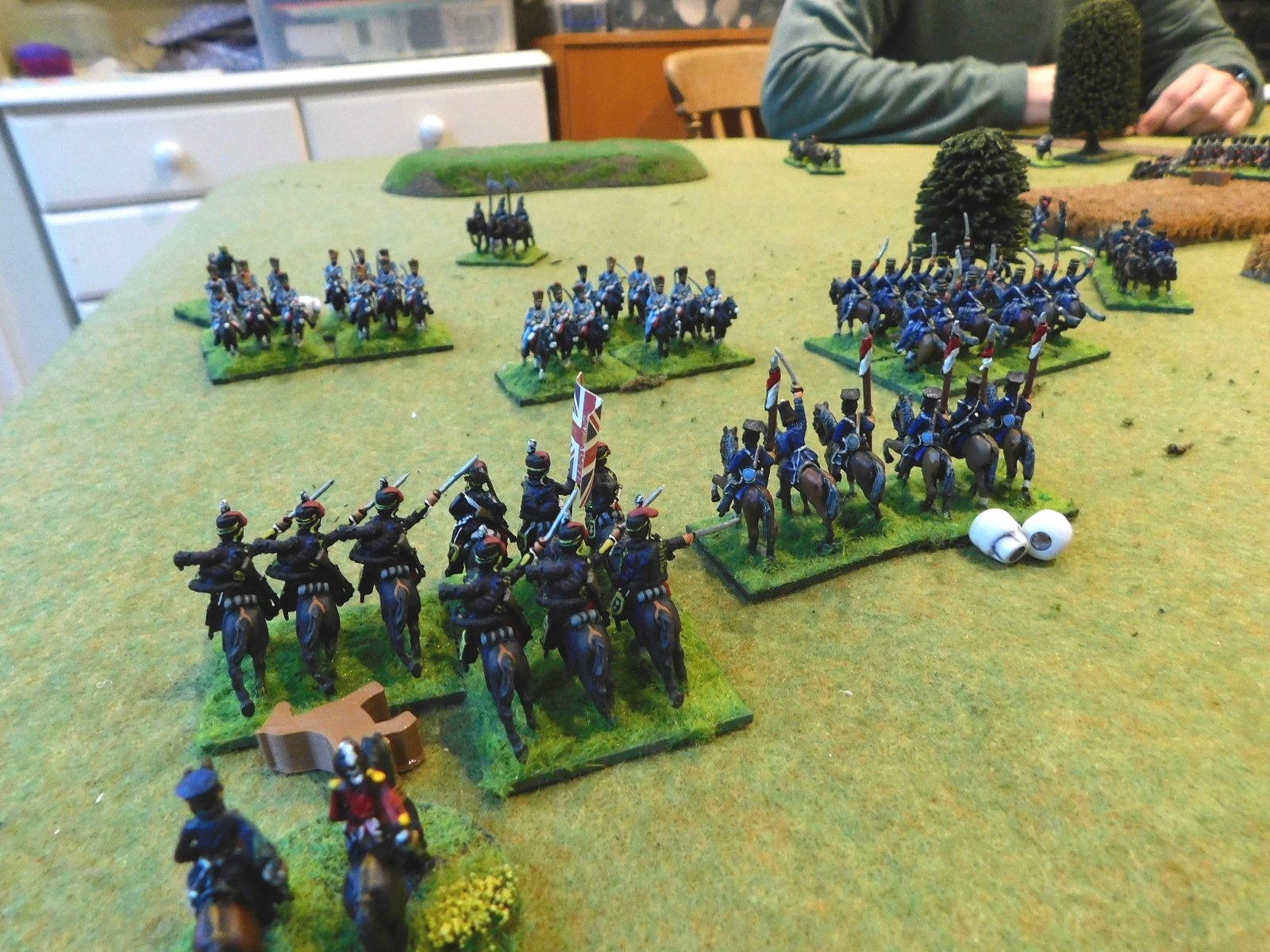
With the two flanks fought to a standstill, resolution was going to occur in the centre.
Extreme Action In The Centre
As previously mentioned, the Russian columns charged into the village, focussing their efforts on the lone battalion of Highland infantry occupying the buildings on the left hand side of the road.
Time and time again, fresh columns of brown clad infantry advanced into the fight until the area was strewn with their corpses, but sheer volume of numbers was beginning to tell and soon there were only a handful of brave Scots left. These resisted for another turn or two, then were finally sent flying, leaving the left hand side of the village in Russian hands,
At the same time as the above, more Russian columns attacked the British battalion holding the right hand side of the village. These crumbled somewhat faster than the Scots, and soon the entire village was in Russian hands! Things looked a bit grim for the Brits!

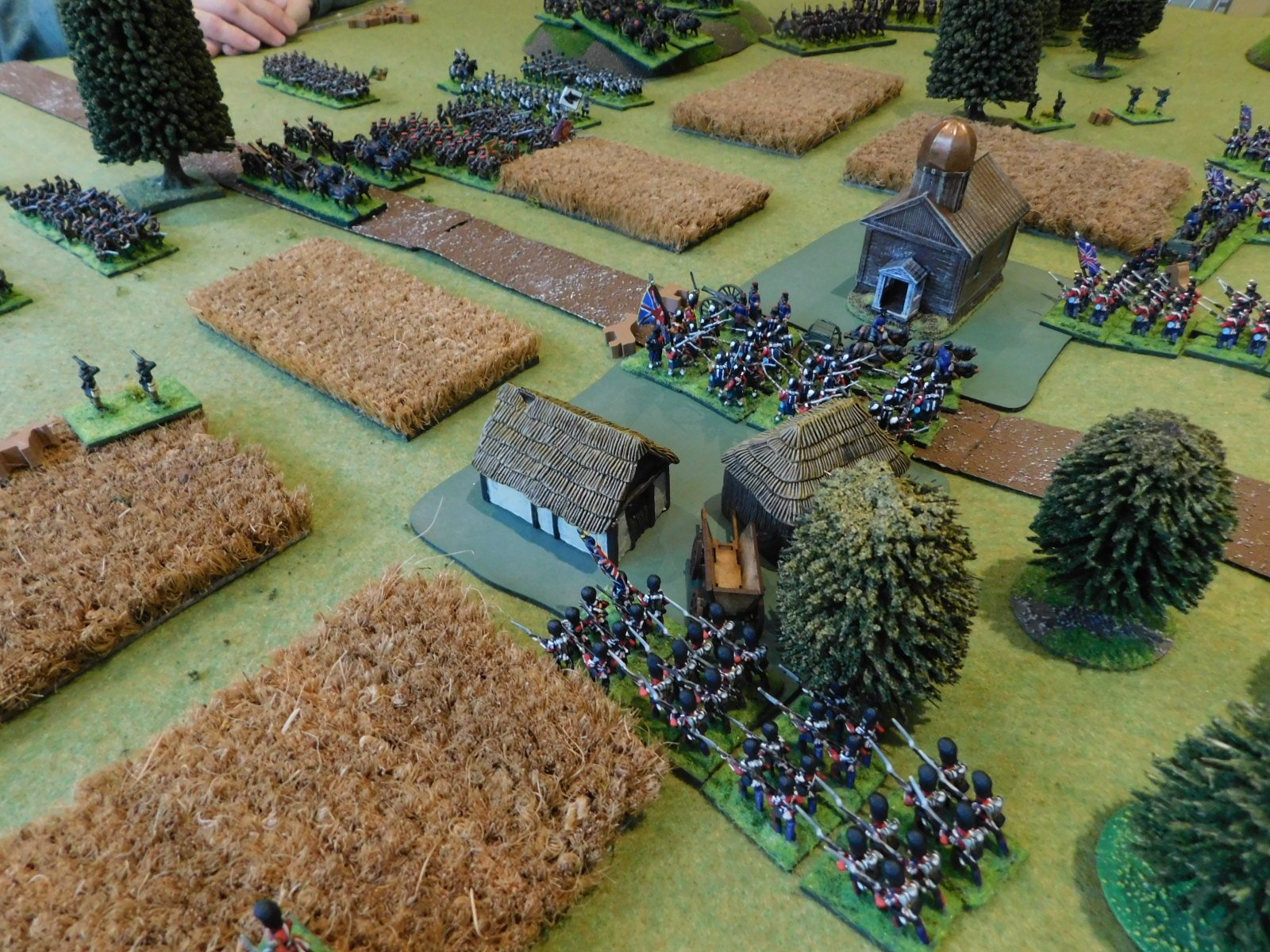



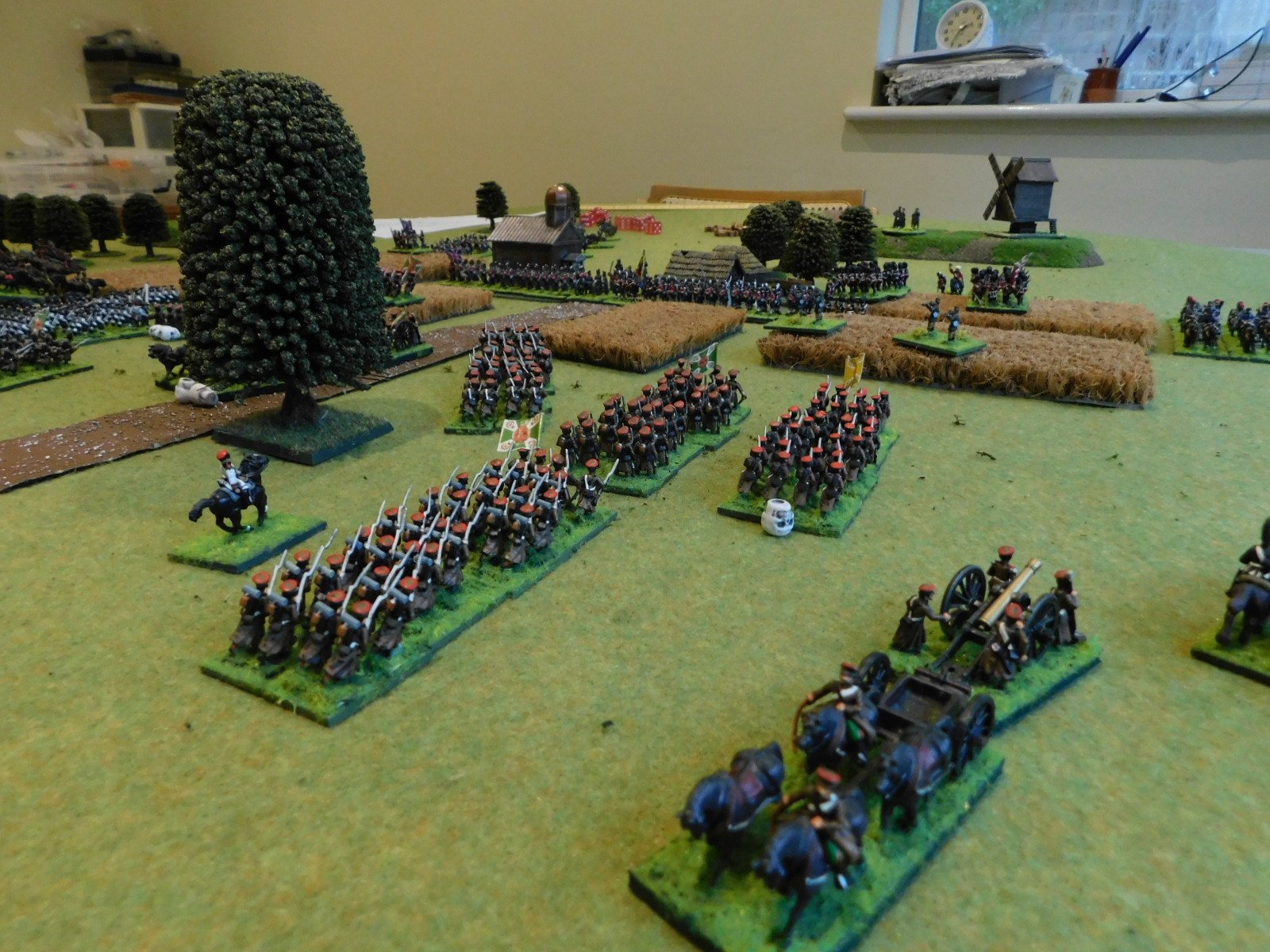
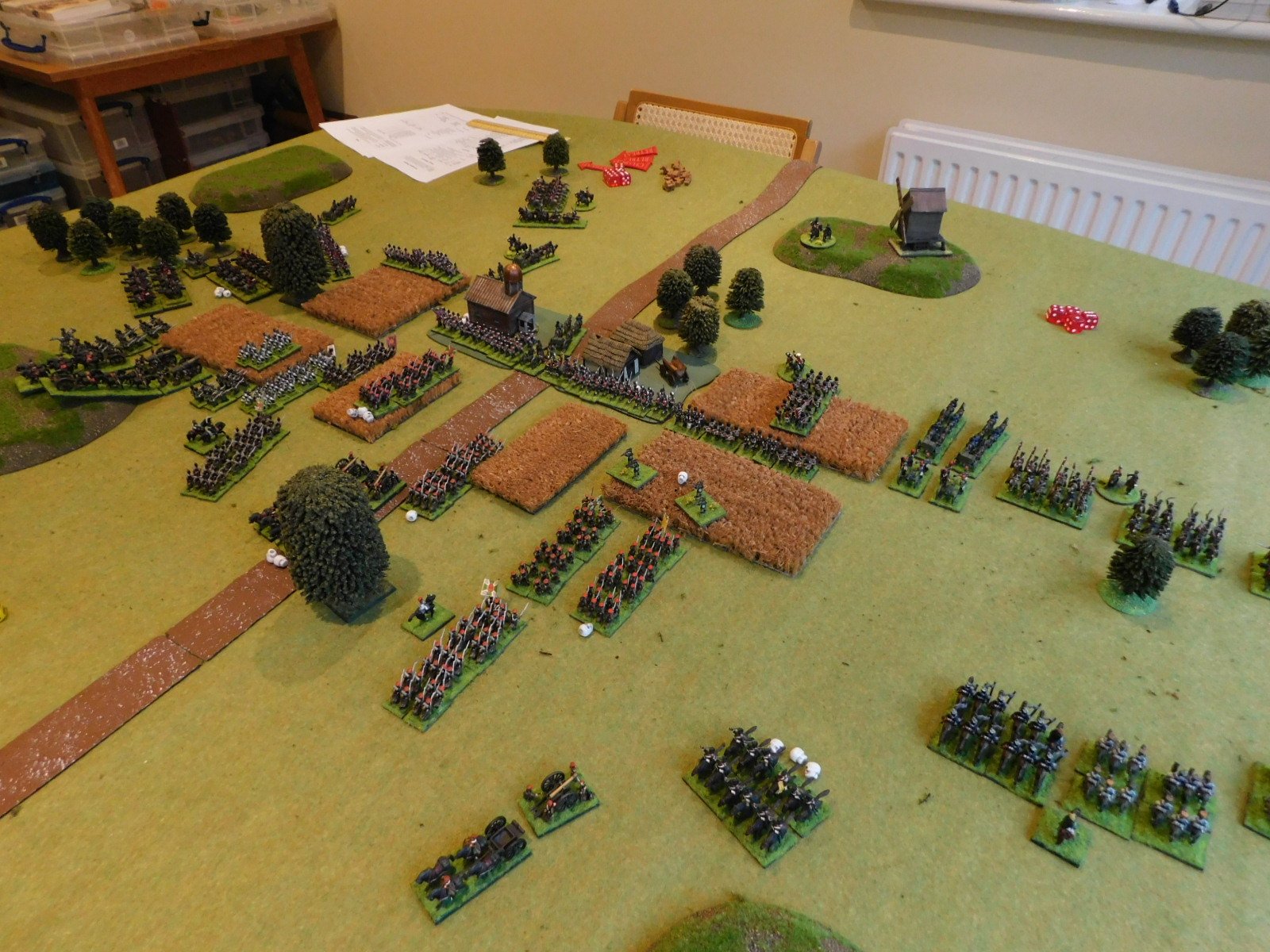
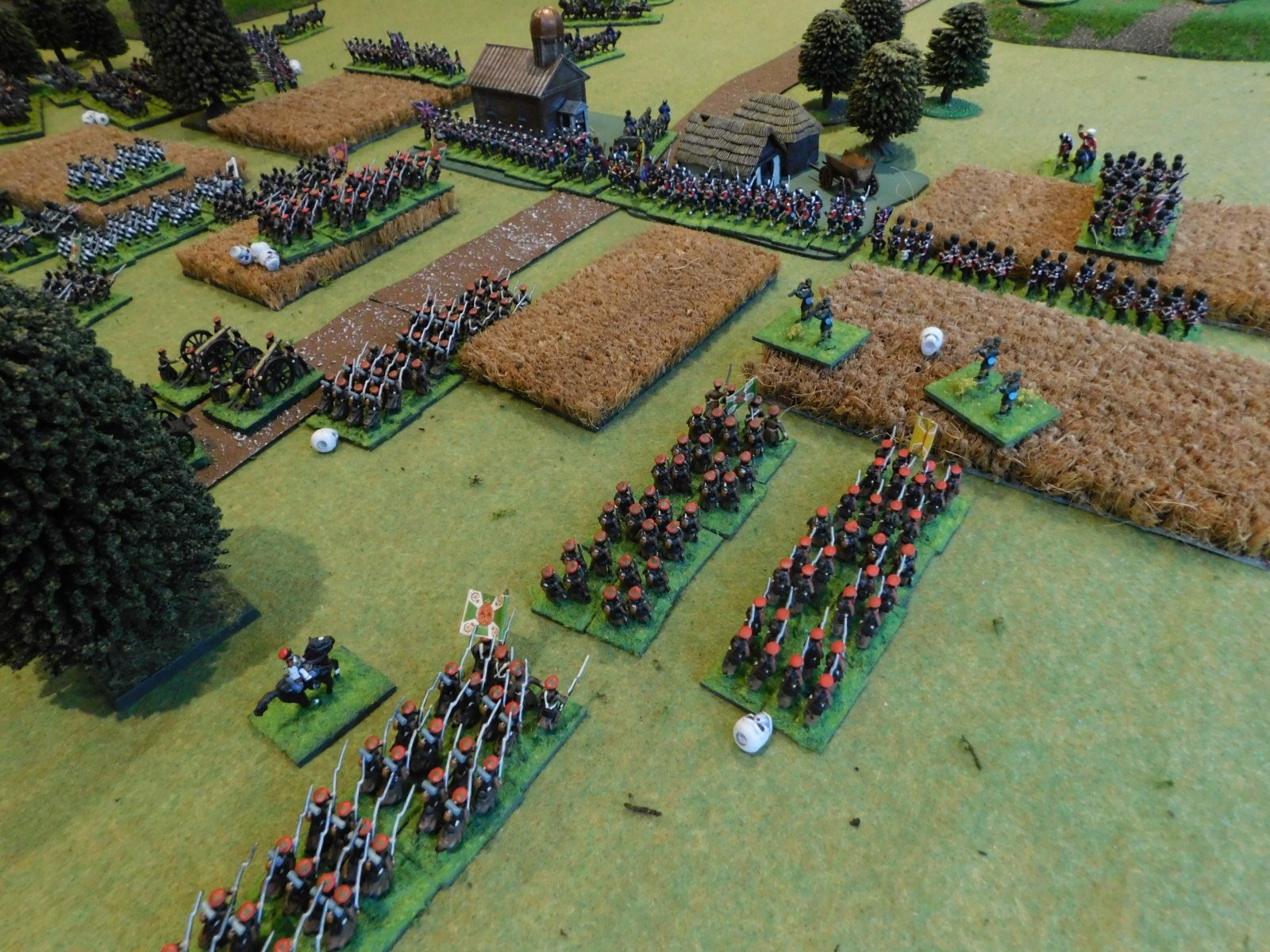



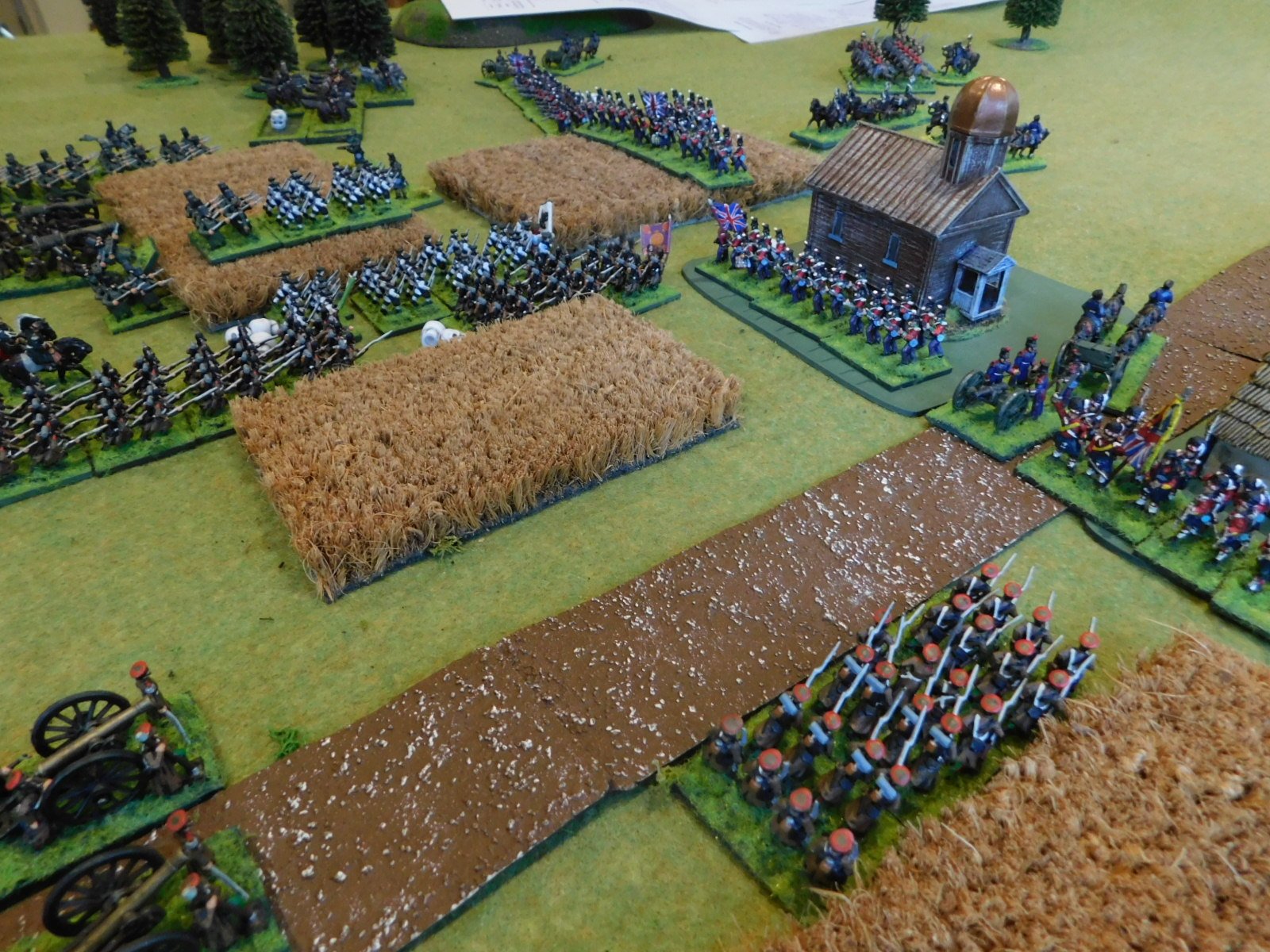


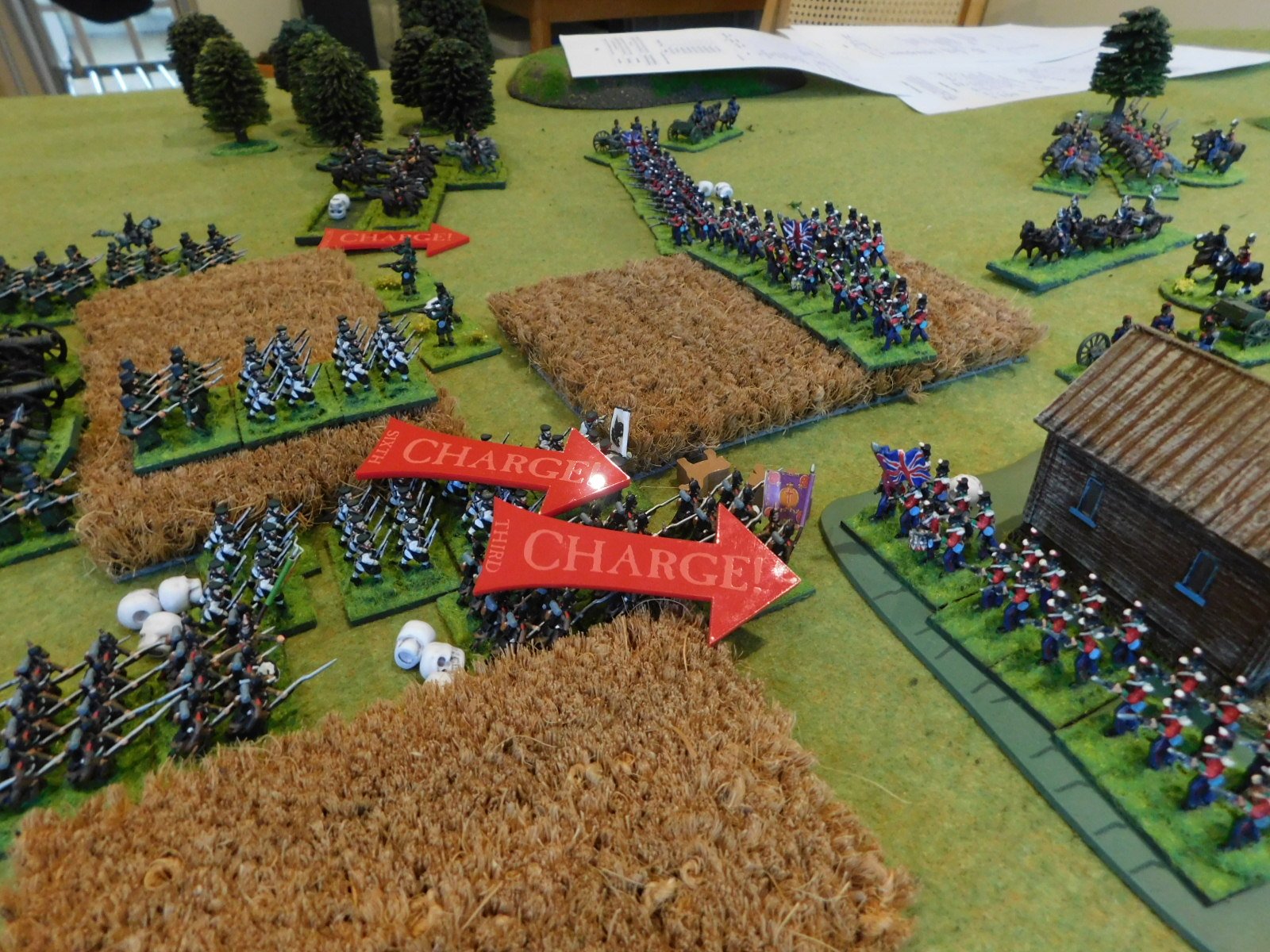

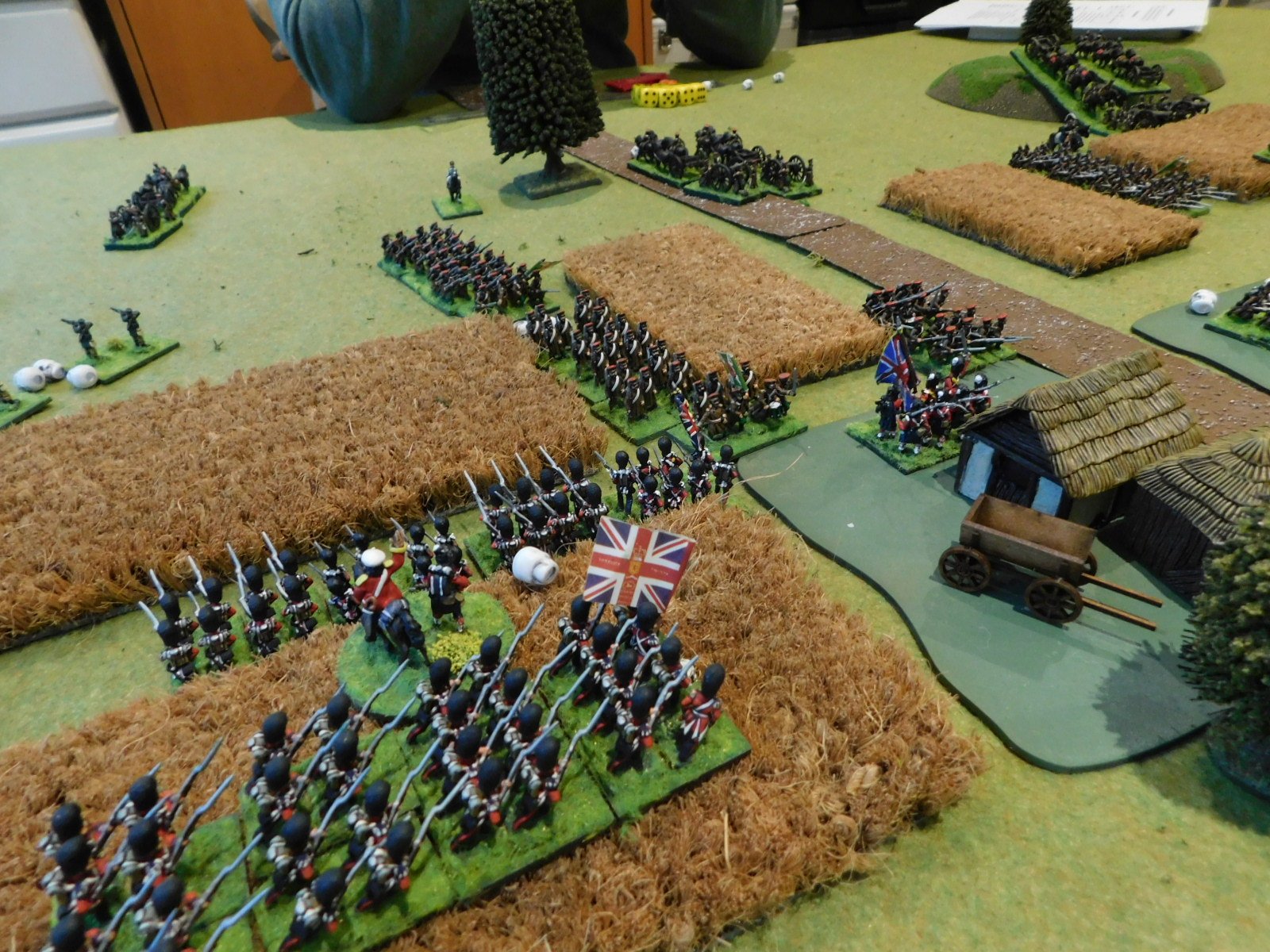
This was, however, only a temporary setback. The two battalions of Guardsmen on the left of the British line had repelled the Russians in front of them and now took the offensive. One formed columns and moved towards the left hand side of the village whilst the other pivoted around its right hand man to flank more Russian columns as they advanced forward.
This proved too much for the Russians, and soon the left hand side of the village was back in British hands, with no more Russian reinforcements on the way.
Meanwhile, on the right of the central British line, a battalion of line infantry had been holding its position in the centre of a cornfield, repelling any Russian columns who came towards them. Fortunately for the Brits, the terrain meant that the Russian attacks had come in piecemeal as opposed to a co-ordinated push.
Although honours were now technically even, with each side holding one half of the village, the Russians were down to only three effective infantry units (from eleven!) whereas the British had only lost two of their six infantry battalions. With the wings stalemated, the Russian commander declined to waste his troops on further assaults, or even to try and hold the gains that they had made, and ordered a general retreat.
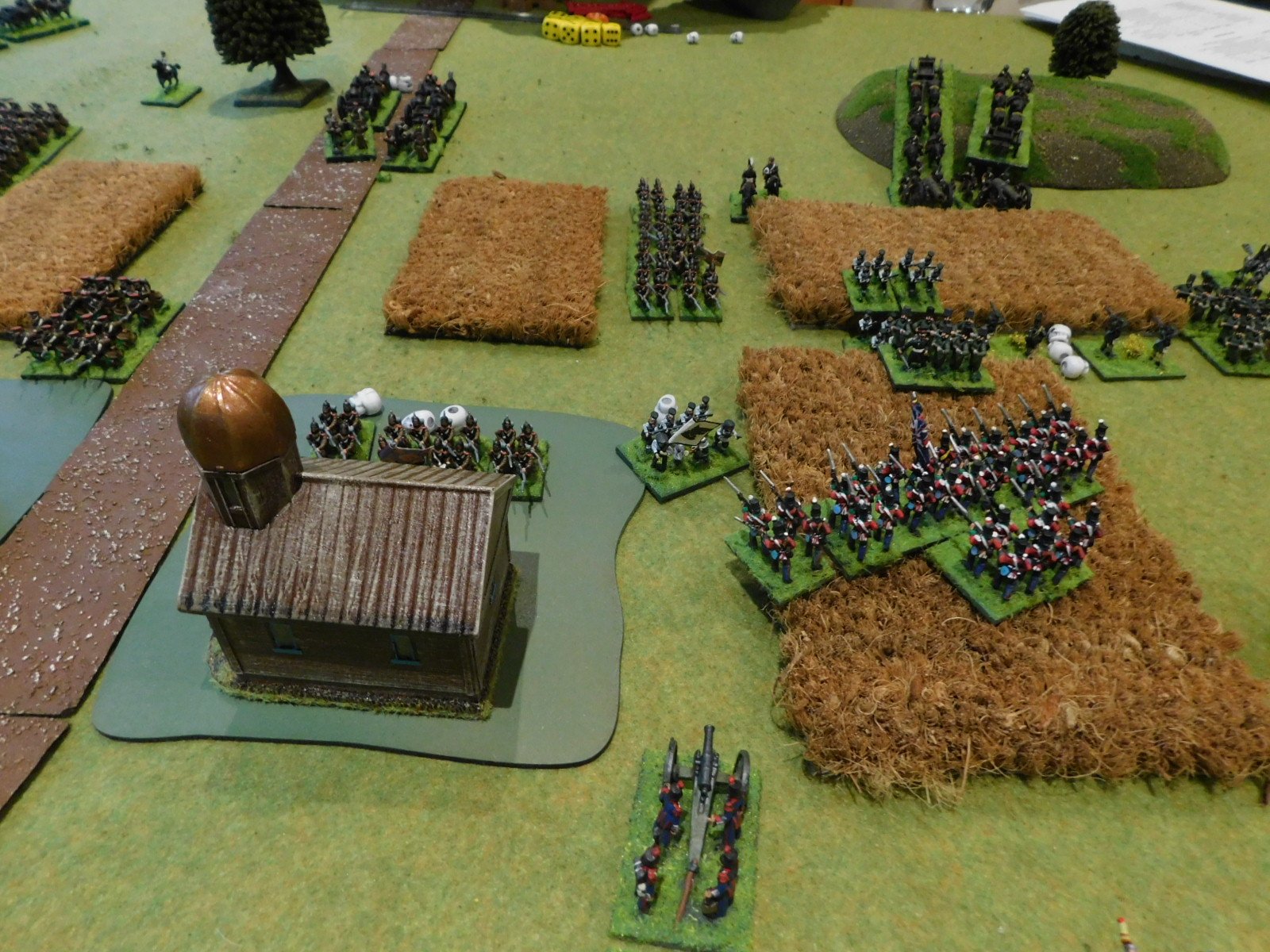
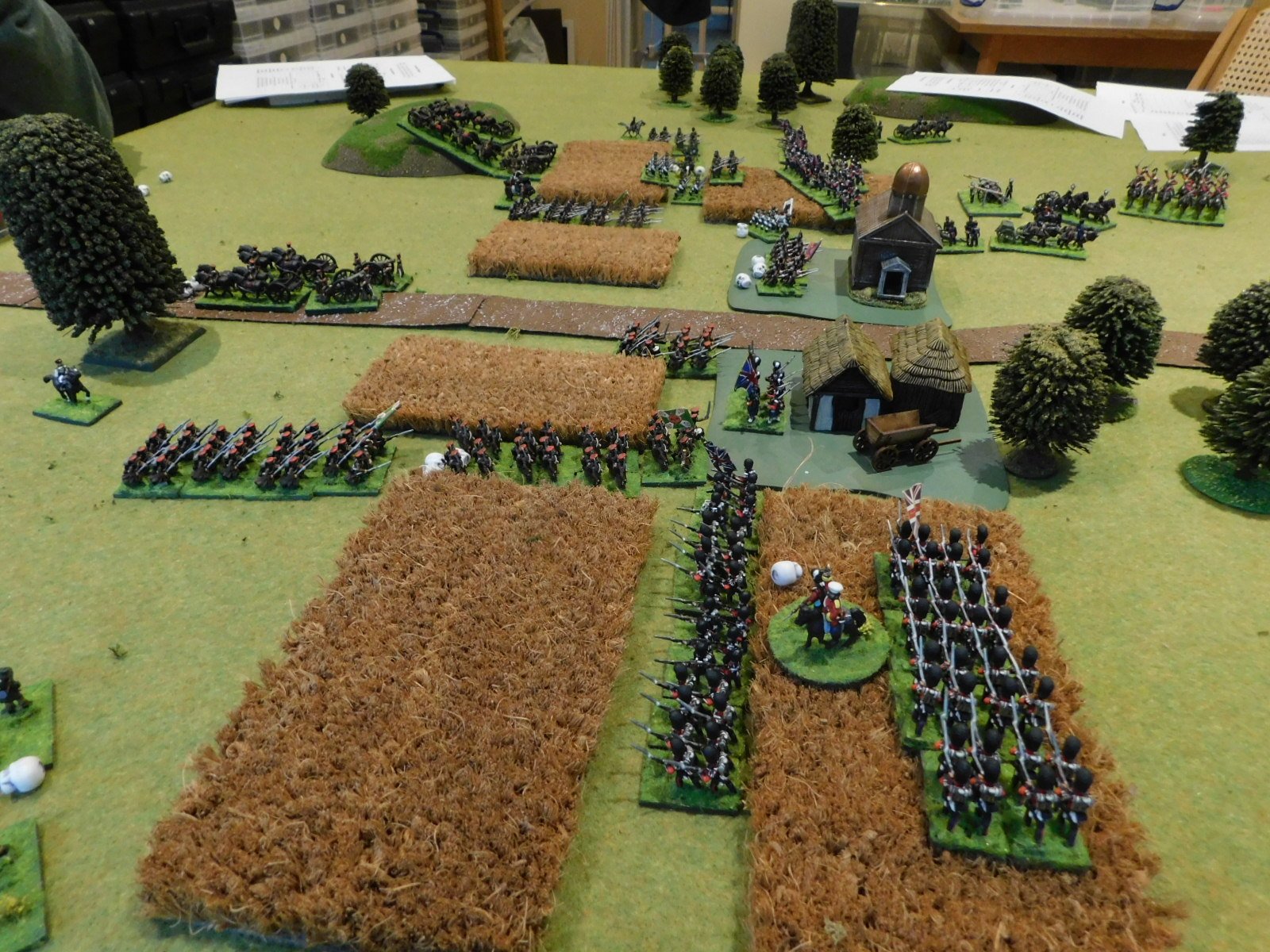

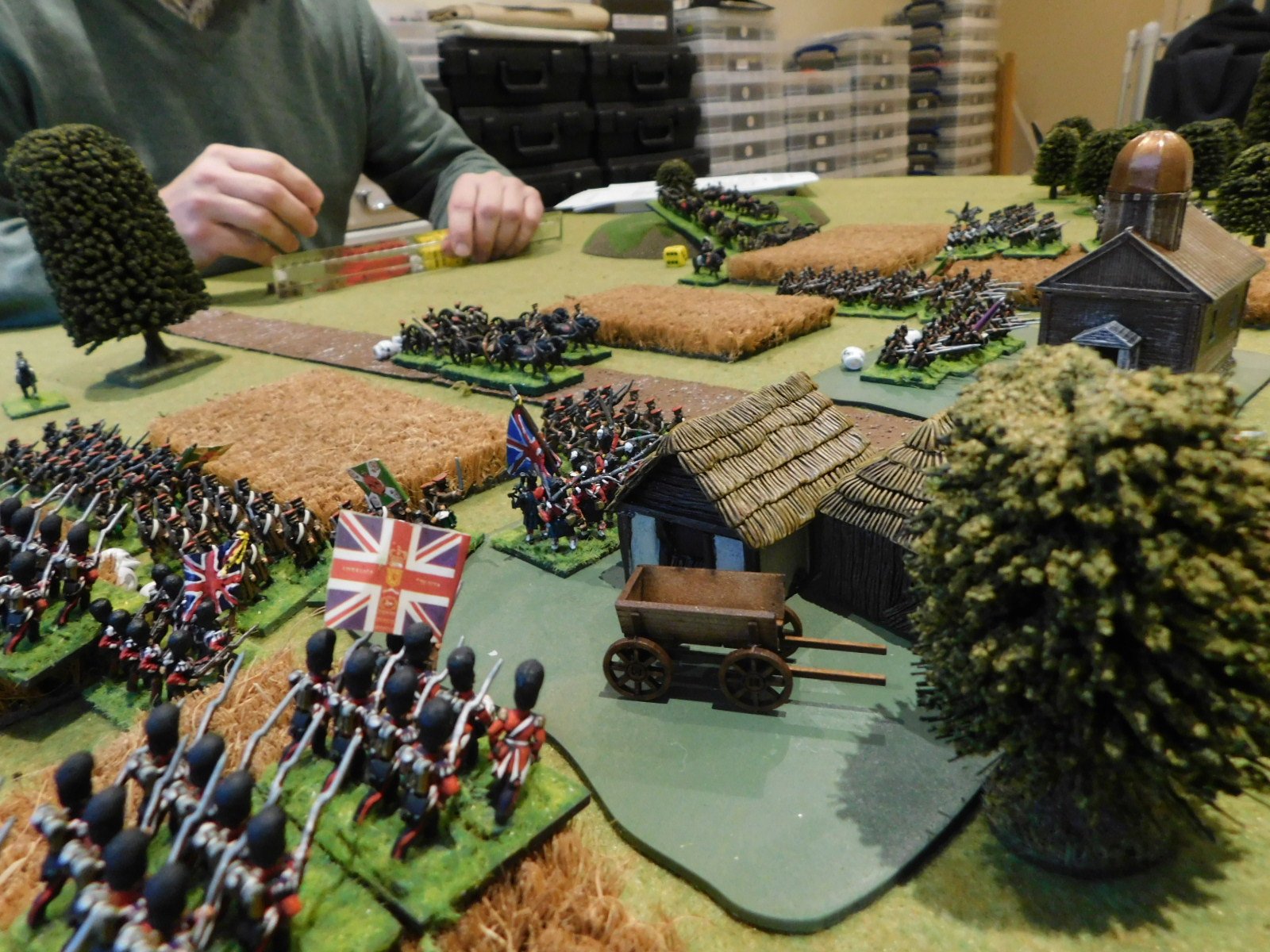
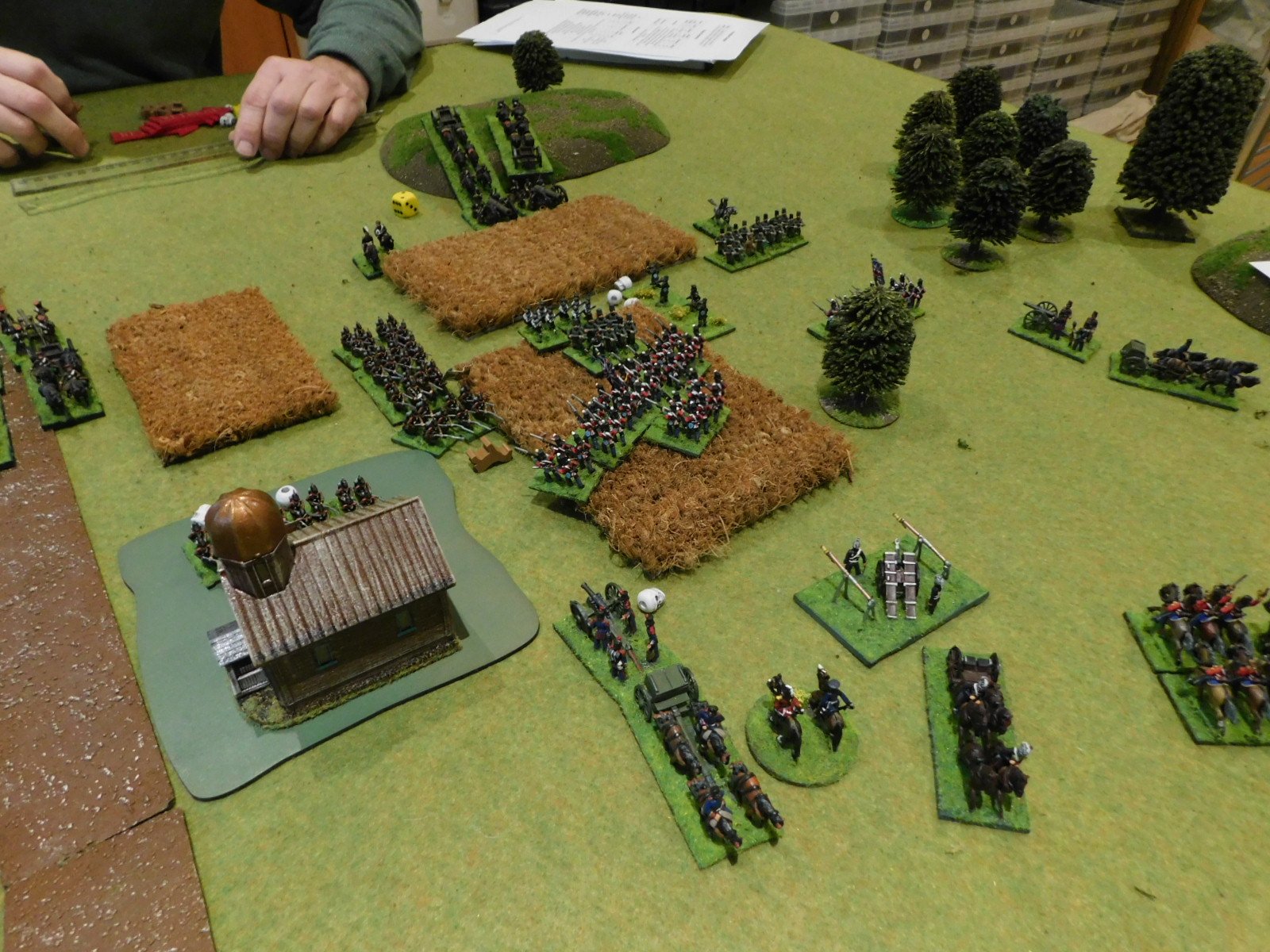
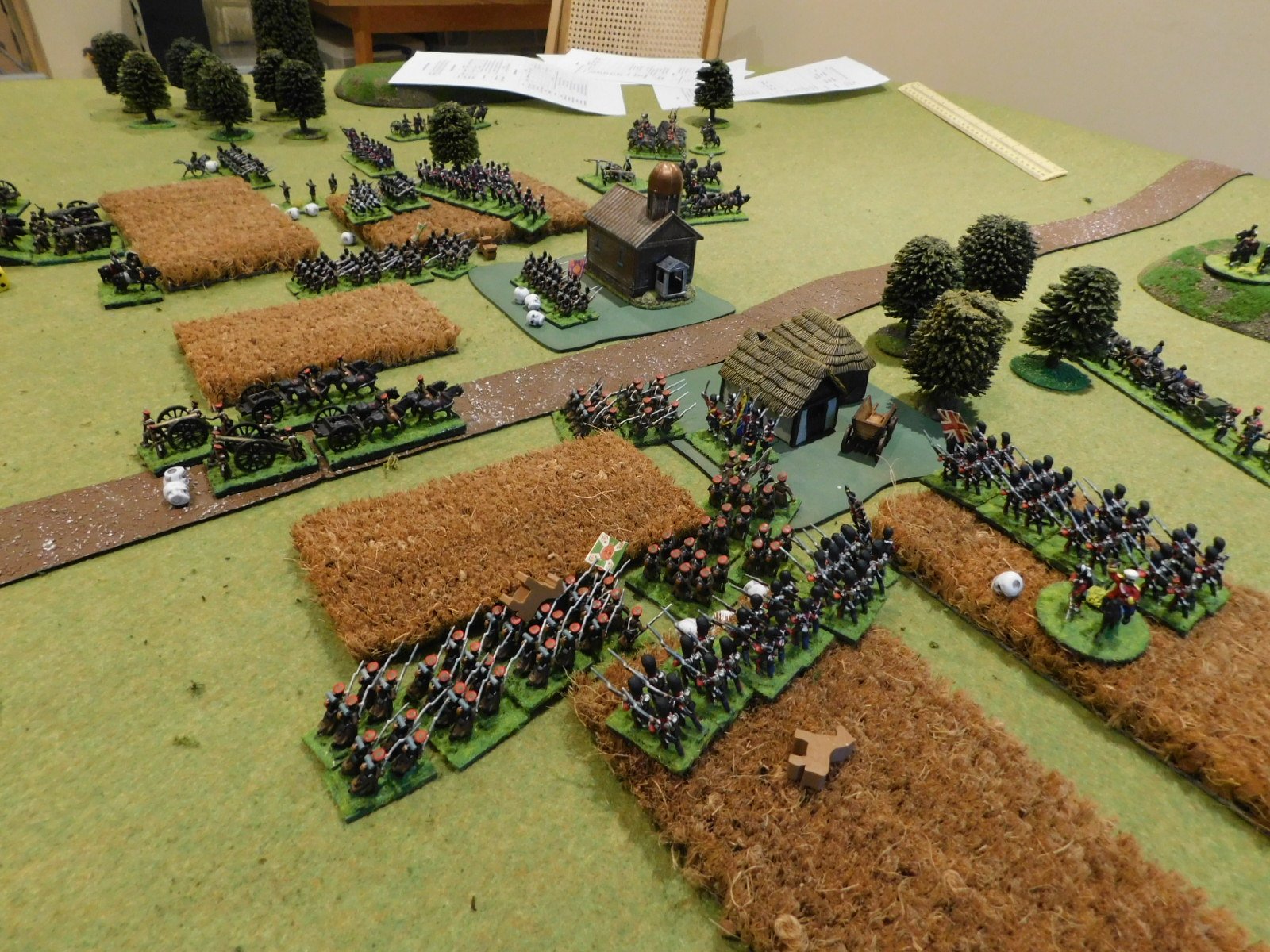

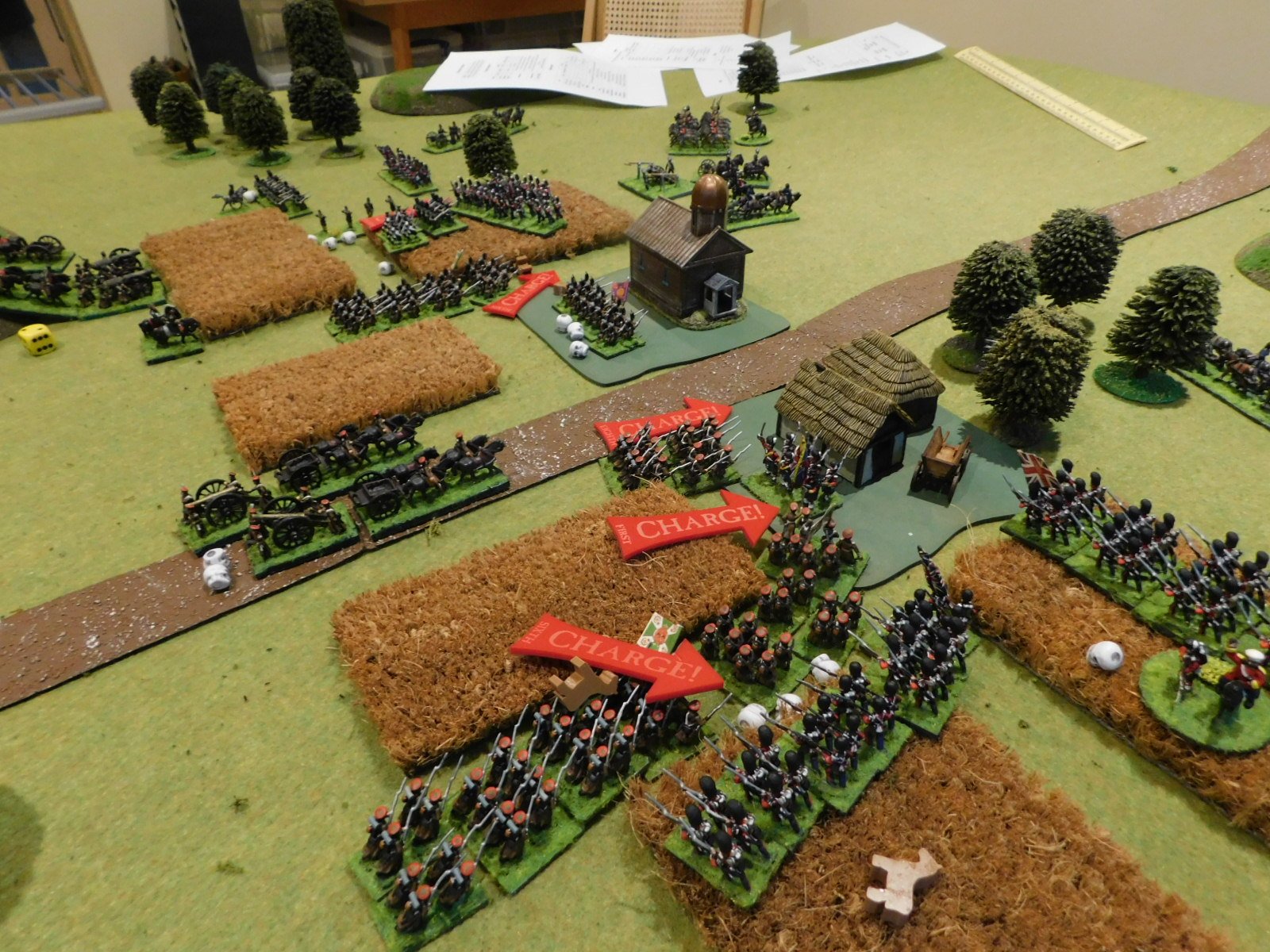


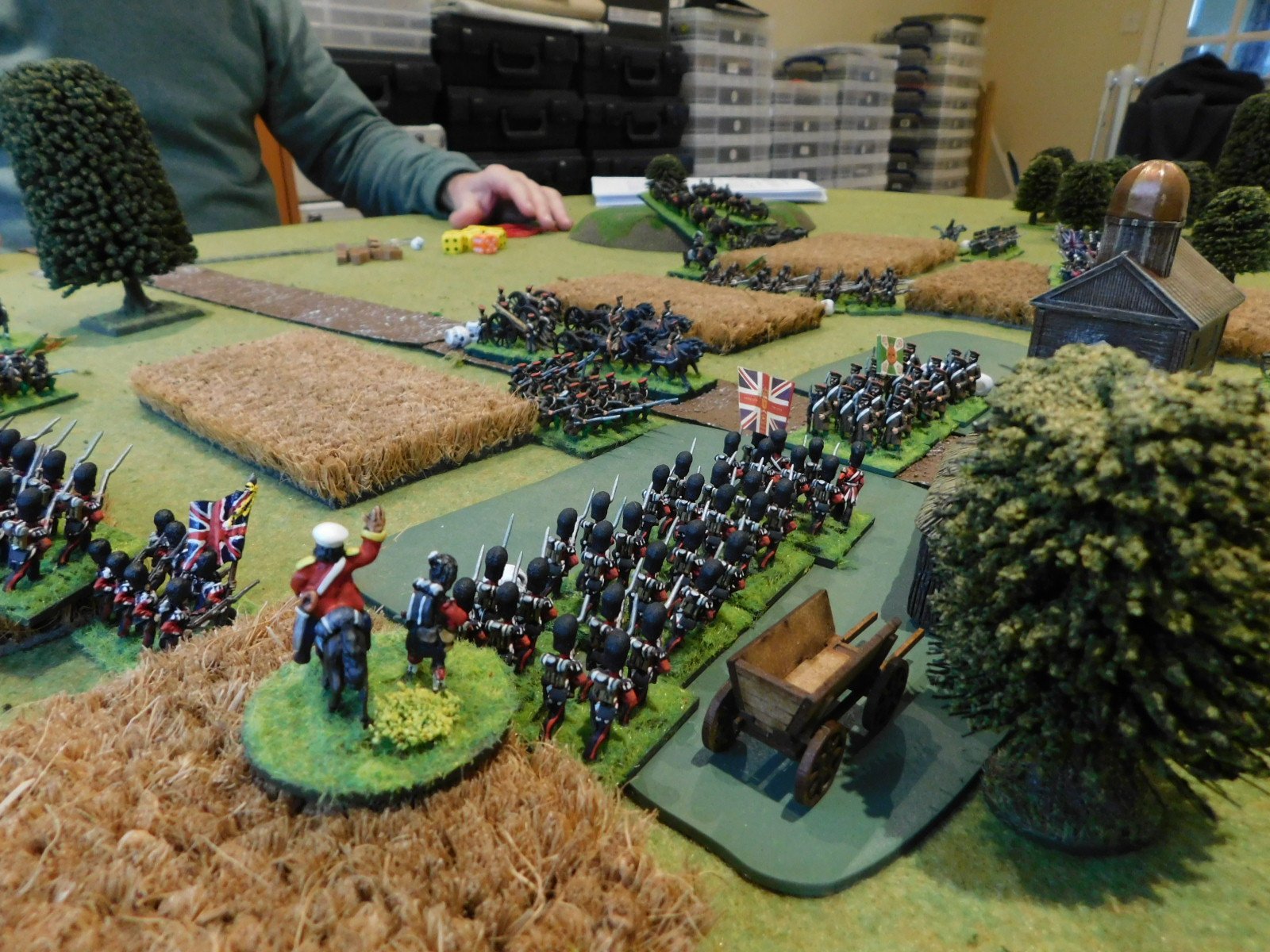
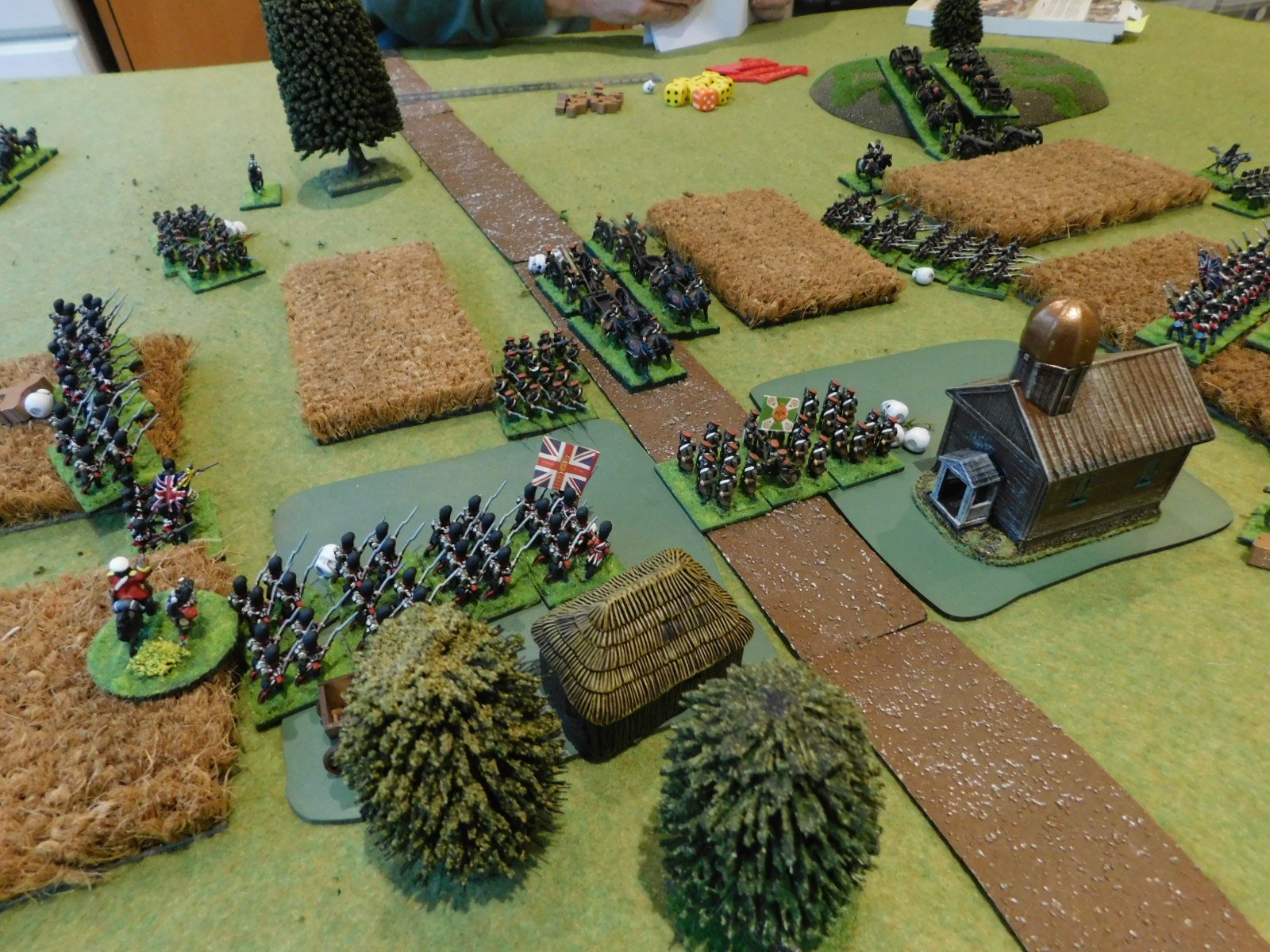
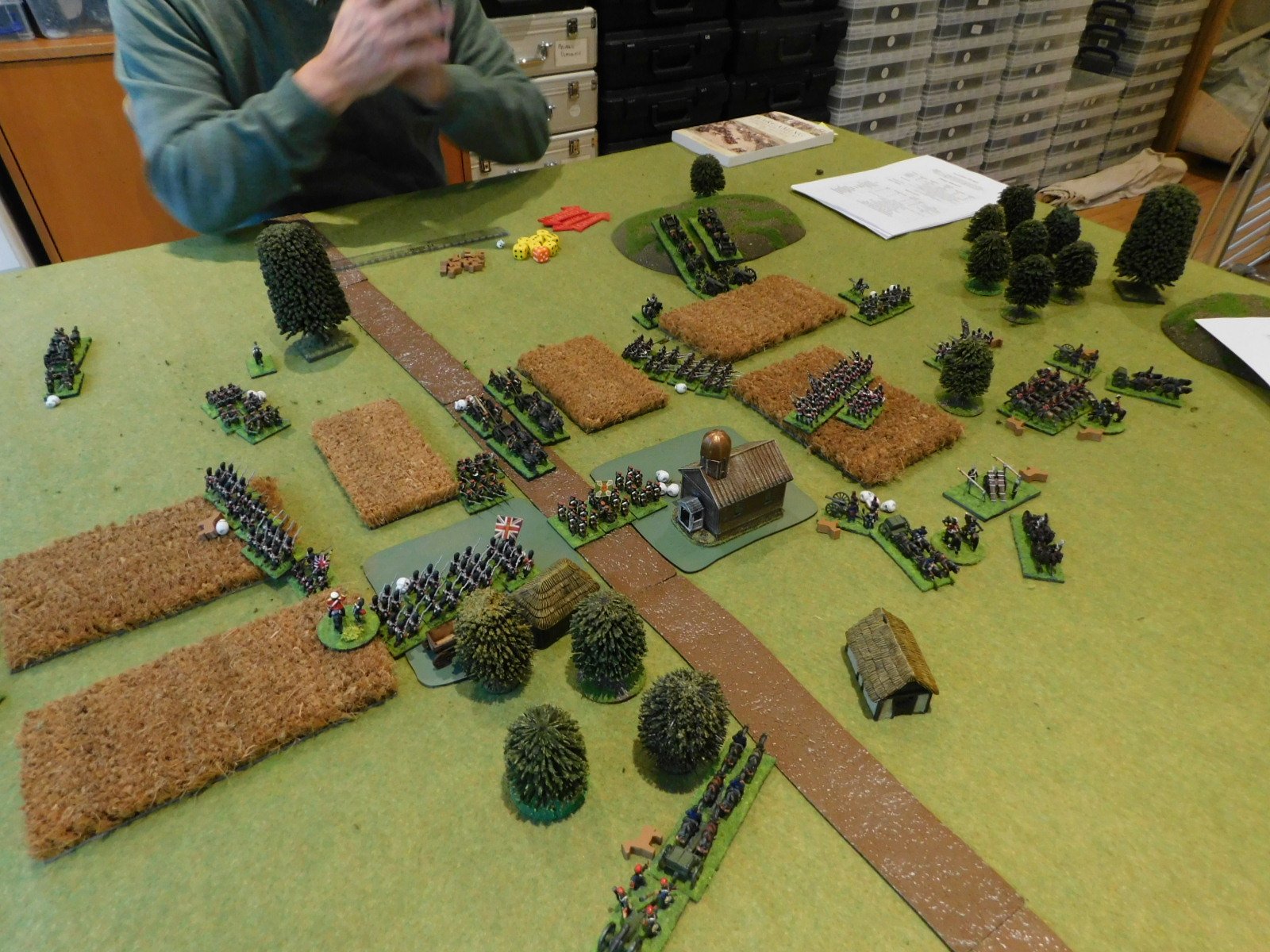
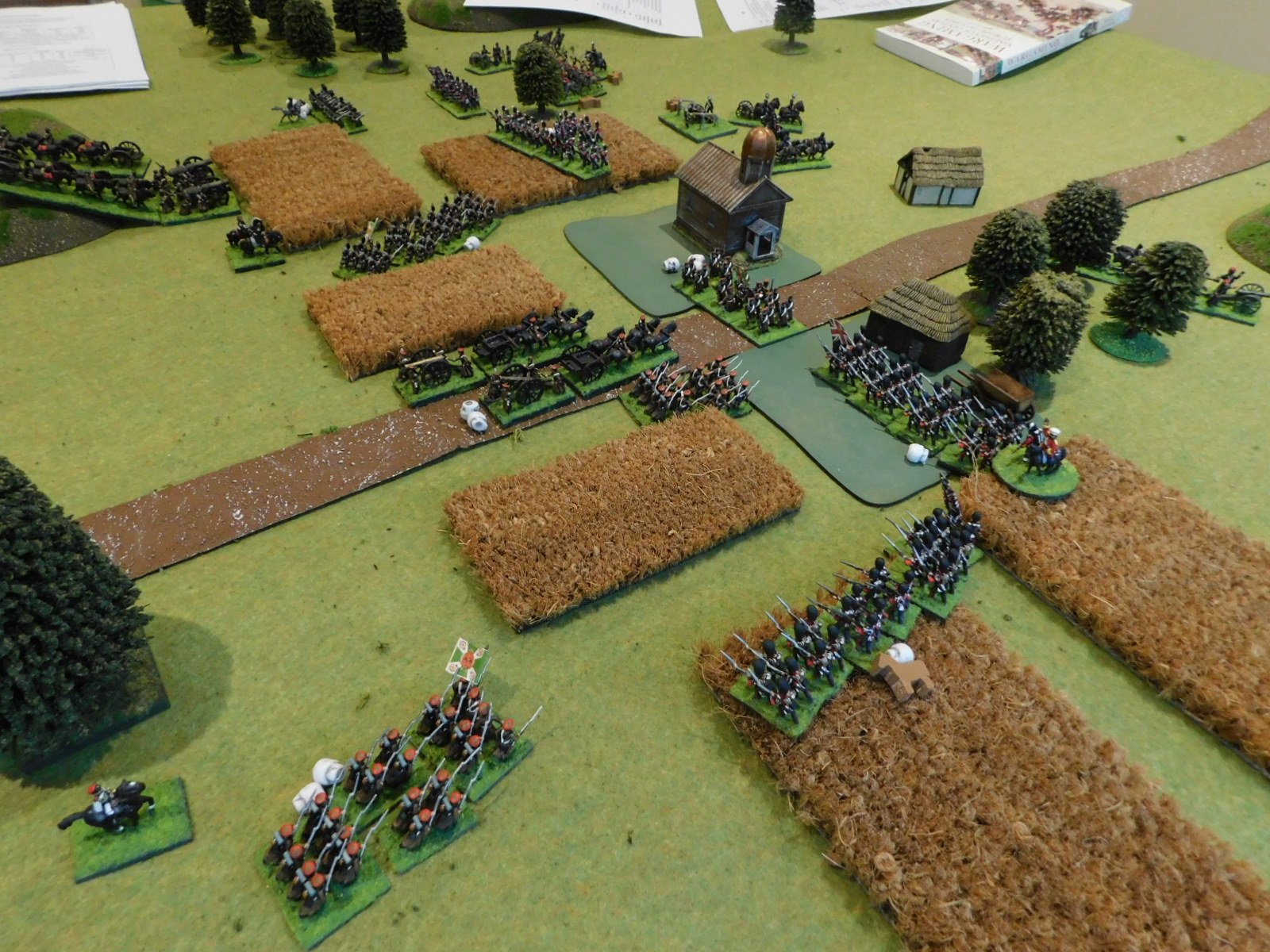
Aftermath
Another great game and one that was actually very close indeed.
When the Russian columns pushed two British battalions out of the village, I was seriously concerned that I wasn’t going to get back into them, especially as my “elite” cavalry were busy getting nowhere.
To finish, here are a couple of shots not included above of the battle in progress:
IABSM AAR: Blenneville or Bust! #01: West of Pierrecourt
/Just before Christmas I had a chance to play a great game of I Ain’t Been Shot Mum using the first scenario from the Blenneville or Bust! scenario pack: West of Pierrecourt.
The Allies are moving up the valley hoping to hook round Pierrecourt to the west. In order to do this, they need to be able to cross the Moire River. There’s a major bridge at Belle Maison, but Belle Maison is apparently full of Germans, so it would be good to find somewhere else to cross. Aerial assets have spotted a small bridge west of Pierrecourt, and the reconnaissance elements of the US 107th Infantry Division (nicknamed the Coyotes) have been sent forward to check it out.
The Germans, meanwhile, are keenly aware that the troops in Pierrecourt are relying on the Moire to protect their wider left flank. As the Allied advance begins, their commanders send out 30th Panzer Division’s reconnaissance units to cover as many river crossings as they can. This scenario covers the first clash between the opposing scouts.
Click on the picture below to see what happened:
TTS AAR: Burgundian Ordnance vs Vikings
/As Bevan had his Vikings out and I wanted to get my still-relatively-new Burgundians onto the table, we decided to have a game that would set the two against each other.
The Viking army was the same that had beaten my Vikings: maxed out on Bondi with a few lights in support. My Burgundians fielded four units of Later Knights supported by four units of sound infantry: three mixed spear or bill and bow units and a unit of crossbowmen. I also had an organ gun present.
View from behind the Burgubdian line: there’s an awful lot of Vikings over there!
The Vikings rushed forward, but were unprepared for the sheer weight of the Burgundian Knights that charged them. Two of my armoured units, shot in by archers to disorder the shieldwalls just before impact, smashed straight through the Vikings in front of them, sending them fleeing for their longships.
One of victorious Knights units then took the enemy camp whilst the other roamed around the centre of the field looking for more Vikings to charge.
Just after the first of the viking shieldwall units disappears from the field
taking the enemy camp (top leftish); rolling them up (centre right)
Meanwhile, on the right, one unit of Burgundian infantry used their horses (i.e. the Mounted Infantry bonus) to advance forward fast enough to split the advancing Viking line. This enabled another unit of Knights to turn right and hit the right flank of the Viking left-flank force that was currently engaged in a massive shoving match with some more Burgundian infantry.
With three Bondi units and their camp now destroyed, this proved too much for the Vikings to bear and, as another Bondi unit fled the field, the rest of the enemy army crumbled and followed. A glorious victory to the Burgundians!
Actually I was a bit lucky on my left, where a huge Viking outflanking force effectively took no part in the game because (a) having the initiative meant I could stay well away from them at set up and (b) Bevan’s attempts to move them into an outflanking position were stymied by the cards, who had obviously decided they didn’t like Vikings any more!
The whole game took only about an hour and further proved the power of the Burgundian charge!
IABSM AAR: Happy Christmas!
/Over the Christmas period, I got a chance to play in a Christmas-themed game of I Ain’t Been Shot Mum set in late December 1944.
It was a Battle of the Bulge scenario, with me playing a US force defending a major supply dump against an attack from a German armoured column. I could expect some support from nearby Brits, but couldn’t be sure when they would arrive.
Click on the picture below to see what happened…
TTS AAR: Vikings vs Vikings: the Decider
/Having fought the Vikings versus Vikings battle twice over with one victory apiece, it was time to play the decider. Forces were unchanged from the last game.
Bevan’s Vikings had the initiative, and soon the two battle lines were thundering towards each other.
Looking at the picture above you’ll see that Bevan overlaps my main line with one unit of Bondi and a unit of lights, facing only a unit of light archers. Knowing I was going to be outnumbered, I had deliberately put my Huscarls (veteran troops indicated by the red Meeple) to protect my flank.
The lines came together with a mighty smash. What you can’t see is that out of frame to the left, his extra unit of Bondi and their accompanying lights are driving my lights backwards and will eventually send them off the table.
Much disorder on both sides after the first clash, with no-one really getting an advantage…which is not what I wanted as I needed to win quickly if I was not to be overwhelmed by superior numbers. Still out of frame to the left are his extra Bondi!
A couple of my units break through the centre, introducing the possibility of an assault on the enemy camp, but there’s now a mass of enemy units on the right flank…
…and worse, as you can see in the picture above, his Bondi on the left have finished dealing with my lights and have manoeuvred themselves into a position from which they can assault my main battle line from the rear!
Those Bondi do indeed charge me from behind and the resultant loss of my end Huscarl unit leads to a general disintegration of my line.
A resounding defeat results!
Aftermath
A great series of Viking vs Viking clashes. You can see from the picture to the right that the two enemy units in front of my Huscarls are about to give way, so if I had just been able to kill them one turn earlier, then my veterans could have turned to face the flanking unit that did so much damage.
The sagas will now record that my Vikings slunk away, defeated. Doubtless they will re-group and be back into action soon!







